Mesophotic environments
Mesophotic environments

Reef corals and coral communities in the mesophotic zone
The mesophotic zone (MZ) is typically defined as being from 30m to 150m depth, intermediate in illumination between its shallower and deeper counterparts. The actual extent of mesophotic-like conditions can vary with the physical state of the local environment, particularly the amount of suspended particulate matter, also known as marine ‘snow’, and its effect on water clarity. Other important factors include steepness of the reef slope, which can determine how much light illuminates the reef, and the type of substrate. These interacting aspects mean that low levels of illumination, creating mesophotic conditions, may occur in depths much shallower than 30m on some reefs, either temporarily or permanently. These are important considerations in respect of the distribution of particular species, those that prefer lower levels of illumination, as these can sometimes be found living in very shallow waters when micro-habitat conditions are favourable.
Some of the first scientific descriptions of corals were made from the MZ, of specimens dredged from 60m or more during research cruises to then remote locations, in the 18th and 19th centuries. This raised the question of just how deep do corals live, a question with a complex, multi-facetted answer. The taxonomic order Scleractinia, to which the reef-building species belong, also comprises an equally diverse group of deep-water species, growing in total darkness at near-abyssal depths. The latter species do not, however, build reefs, and are not included in this work. For the reef-building species, the answer of a lower depth limit was also not immediately apparent, in part because of logistic constraints in the era before SCUBA, submersibles and remotely operated vehicles (ROVs). Today, we know that the lower limit for reef-building corals is in the vicinity of 160m depth, in waters of high clarity, and hence the group is restricted to the euphotic, including mesophotic, zone.
As a matter of historical interest, the growth, depth distribution and fundamental role of corals in the formation of reefs were topics that fascinated many early scientists, including Charles Darwin. During his voyage on the Beagle in the 1830s, the young naturalist became intrigued by reef formation and distribution. Darwin was particularly fascinated by coral atolls, which rise like steep-sided mountains from great depths, often in mid-ocean. This was mysterious, as it was already apparent that reef-building corals thrived in warm, sun-lit waters. So how could atolls rise from the deep, dark seabed thousands of metres below sea level? Perhaps there were other reef-building corals growing at greater depths. Various competing theories were proposed by prominent naturalists of the day, yet it was Darwin’s seminal book, published in 1842, that resolved the mystery of reef growth and atoll formation (Darwin, 1842).
As Darwin realised, through witnessing various stages in the process during his travels, atolls form through a long sequence of events over millions of years, progressively encompassing most other types of reef in the process. After drifting in the plankton as planula larvae, corals initially settle on the shallow wave-washed sides of emergent volcanoes or other sea-girt mountains. Over time, continuing coral recruitment and growth leads to the formation of fringing coral reefs. As the mountains subside and are eroded by rain, wind and waves, the initial fringing reefs become barrier reefs, surrounding a much smaller central mountain top and its circling lagoon. With further subsidence and erosion, the mountain that provided the initial substrate for reef growth vanishes below the waves, and the surrounding reefs ultimately become an atoll, as new generations of coral continue to grow on the underlying reef basement provided by older generations.
Through the entire process, the reef-building corals never grow in deep, dark waters, although their skeletal remains ultimately end up there, as demonstrated by drill cores that penetrated thousands of metres of consolidated reef before reaching the igneous rock basement. So Darwin’s insight, made more than a century before those cores were drilled, or indeed before the theory of plate tectonics could explain mountain subsidence, was that atolls form from the top-down, rather than the bottom-up.
Darwin’s insight was also remarkable in that the underlying reason for the reef-building corals’ strong reliance on shallow sunlit waters was also not understood. Yet, as is well known today, it is the crucial piece in the puzzle of coral and reef growth.
Corals thrive in the shallows because this is the environment most conducive to photosynthesis by their endo-symbiotic zooxanthellae, microscopic dinoflagellates that until recently were considered to belong in just one genus, Symbiodinium. Now, detailed morphological and genetic analyses have revealed a wealth of different zooxanthellae species in multiple newly-described genera, including Breviolum, Cladocopium, Durusdinium and Gerakladium (LaJeunesse, Parkinson, Gabrielson et al., 2018). These provide nutrition to their coral hosts (see Algal symbiosis and mass bleaching). It is now known that there are at least 10 species involved, with different tolerances to environmental conditions. It is also now apparent that some coral species can harbour more than one kind of zooxanthellae, and that in some cases these can be shuffled, and even switched, during and after sub-lethal disturbances. Nevertheless, the intensity of recent impacts has overwhelmed these adaptive mechanisms in many reef regions, with widespread and continuing loss of corals, particularly in shallow parts of reefs. Corals living deeper down, in the MZ, occasionally avoid the worst effects of coral bleaching, a major reason for the increasing research focus.
Yet the diversity of reef-building corals declines rapidly with increasing depth, particularly below 60m, as a small suite of specialist corals increasingly predominates. With the recent and continuing research focus on mesophotic habitats, and use of remotely operated vehicles, future work will undoubtedly reveal more of these specialist corals, although certainly their diversity will never rival that of the better illuminated shallows. Here, we focus mostly on the upper part of the mesophotic zone, above 60m depth, where coral diversity tends to remain high.
Variation in upper mesophotic habitats
Increased focus on the MZ has indicated that mesophotic environments are highly varied in their topography and physico-chemical conditions. MZ reef slopes range from the horizontal to beyond vertical and are composed variously of sand, rubble, small to large reef blocks or consolidated reef walls. Ambient sea temperatures also vary within and among habitats, with some places having a near-constant regime, others having significant shifts in temperature on hourly, daily or seasonal time scales. Such shifts are often related to tidal or other forms of current flow, carrying different water masses, and can result in rapid vertical movement of thermoclines.

Sea fans and small reef-building corals on steep slope of continuous reef pavement and small blocks at 38m depth. Palau Photograph: Emre Turak and Lyndon DeVantier Figure 1.
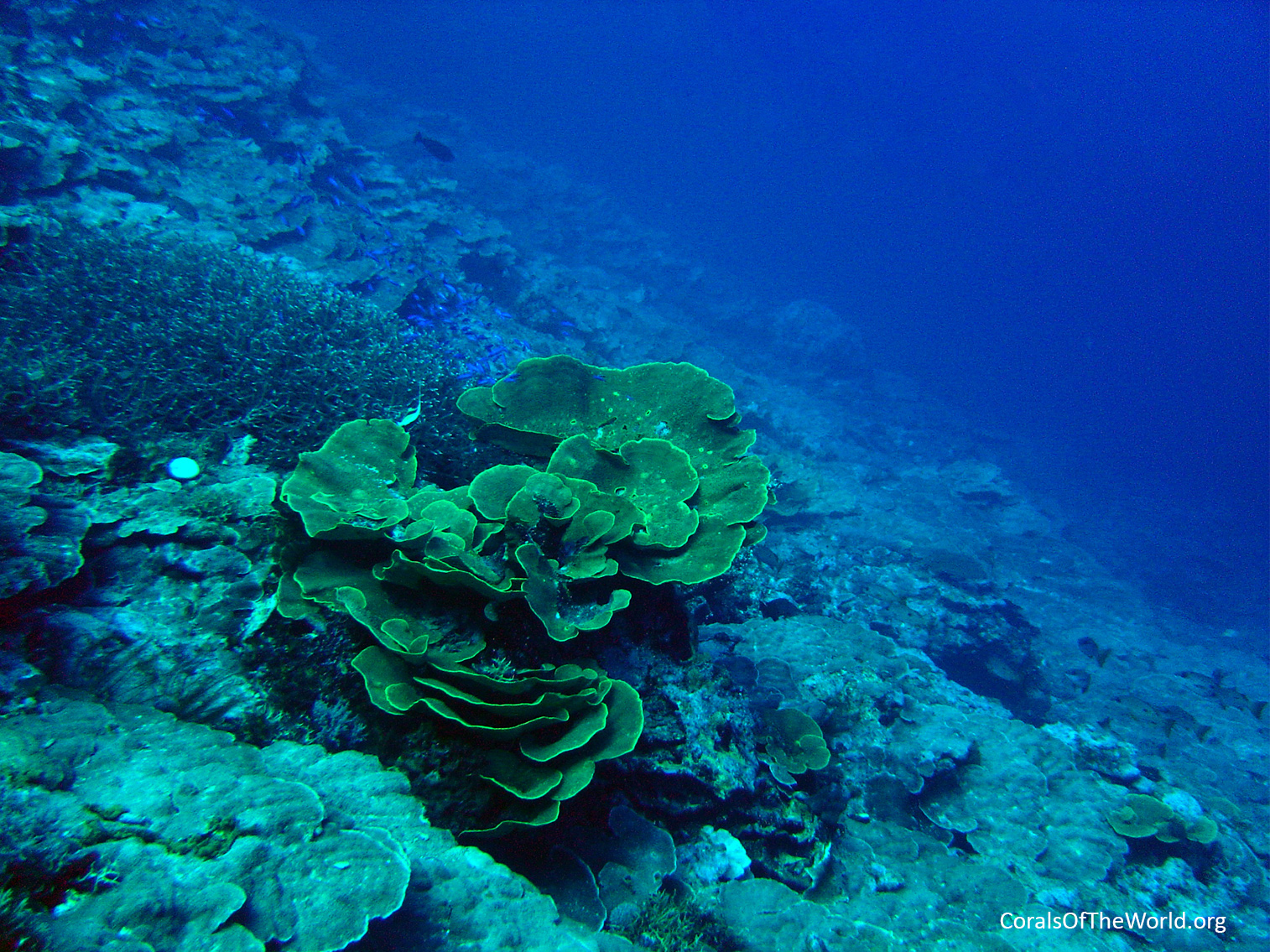
Foliose and plating colonies of Turbinaria reniformis, Porites rus and Porites massive spp. on a moderate slope of continuous pavement and small to large reef blocks, 40m depth. Pohnpei, Micronesia Photograph: Emre Turak and Lyndon DeVantier Figure 2.

Gentle slope of sand-rubble and small reef blocks with only sparse corals at 36m depth Anambas Islands, Indonesia Photograph: Emre Turak and Lyndon DeVantier Figure 3.
It is also now apparent that mesophotic habitats host a much more diverse coral fauna than previously expected, particularly the upper MZ from 30m to 60m depth. In the Indo-west Pacific, more than 300 reef-building coral species are now known to occur in the UMZ (Turak and DeVantier, 2019), and this provisional tally will undoubtedly increase with further research. The vast majority of these species also commonly occur in shallower habitats, as there are very few true MZ specialist corals.

Near-vertical reef slope of continuous pavement with sea fans, black corals and small reef-building corals at 40m depth Solomon Islands Photograph: Emre Turak and Lyndon DeVantier Figure 4.
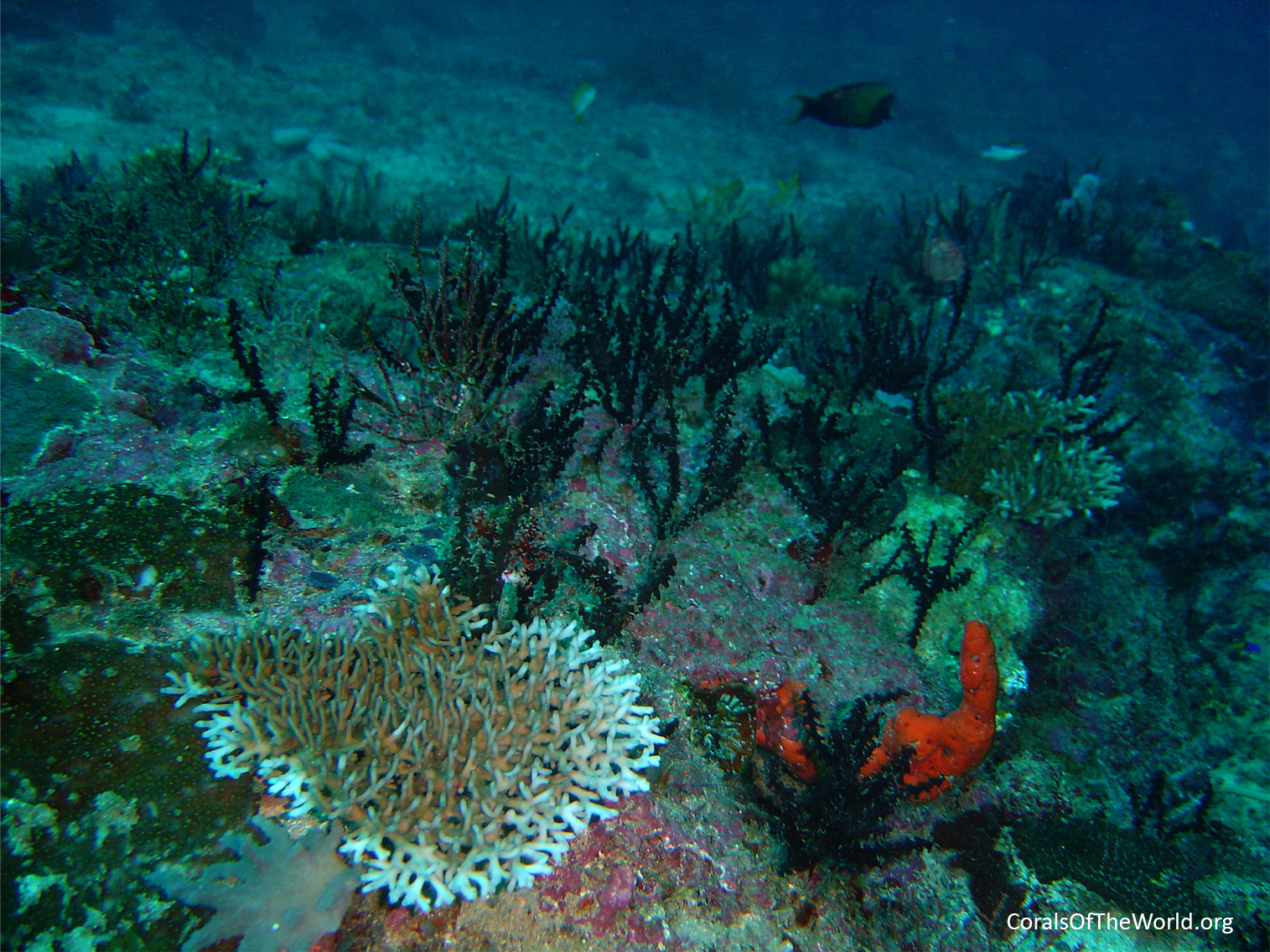
Gentle slope with patches of continuous pavement, sand and rubble with sparse Acropora elegans colonies among diverse invertebrate and algal assemblages at 43 m depthSolomon Islands Photograph: Emre Turak and Lyndon DeVantier Figure 5.
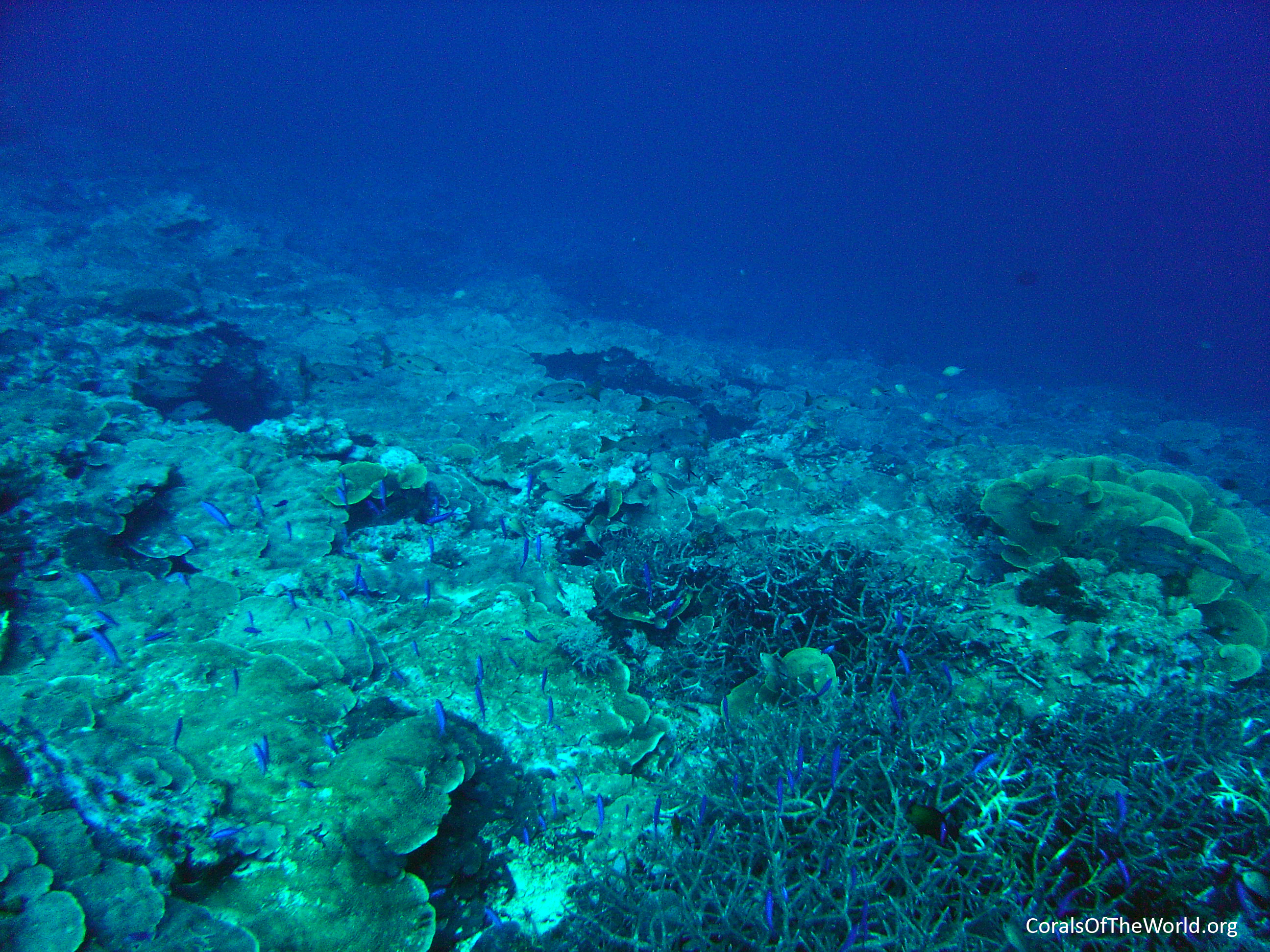
40m. Pohnpei, Micronesia Photograph: Emre Turak and Lyndon DeVantier Figure 6.
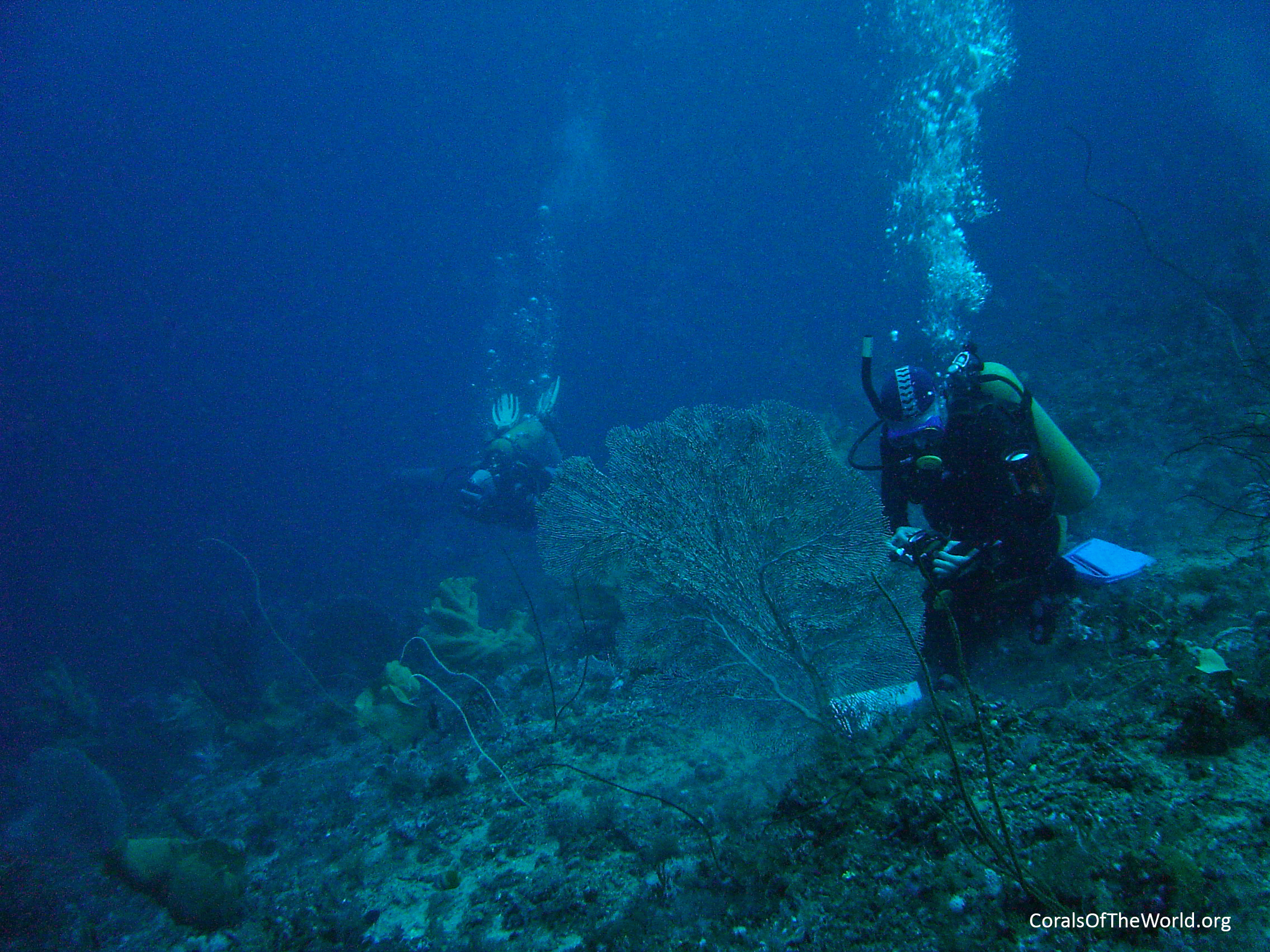
40m. Raja Ampat Photograph: Emre Turak and Lyndon DeVantier Figure 7.
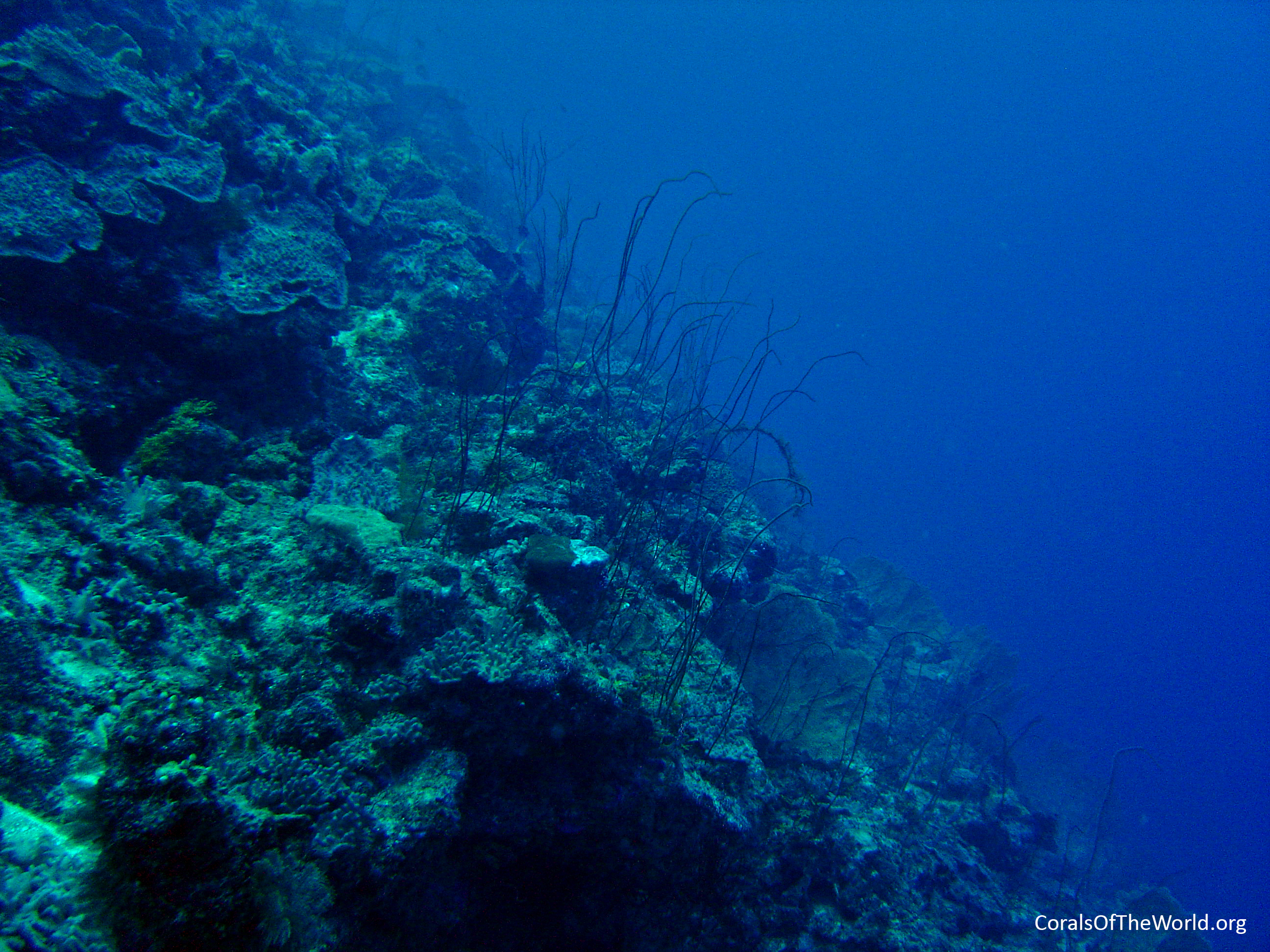
40m. Raja Ampat Photograph: Emre Turak and Lyndon DeVantier Figure 8.
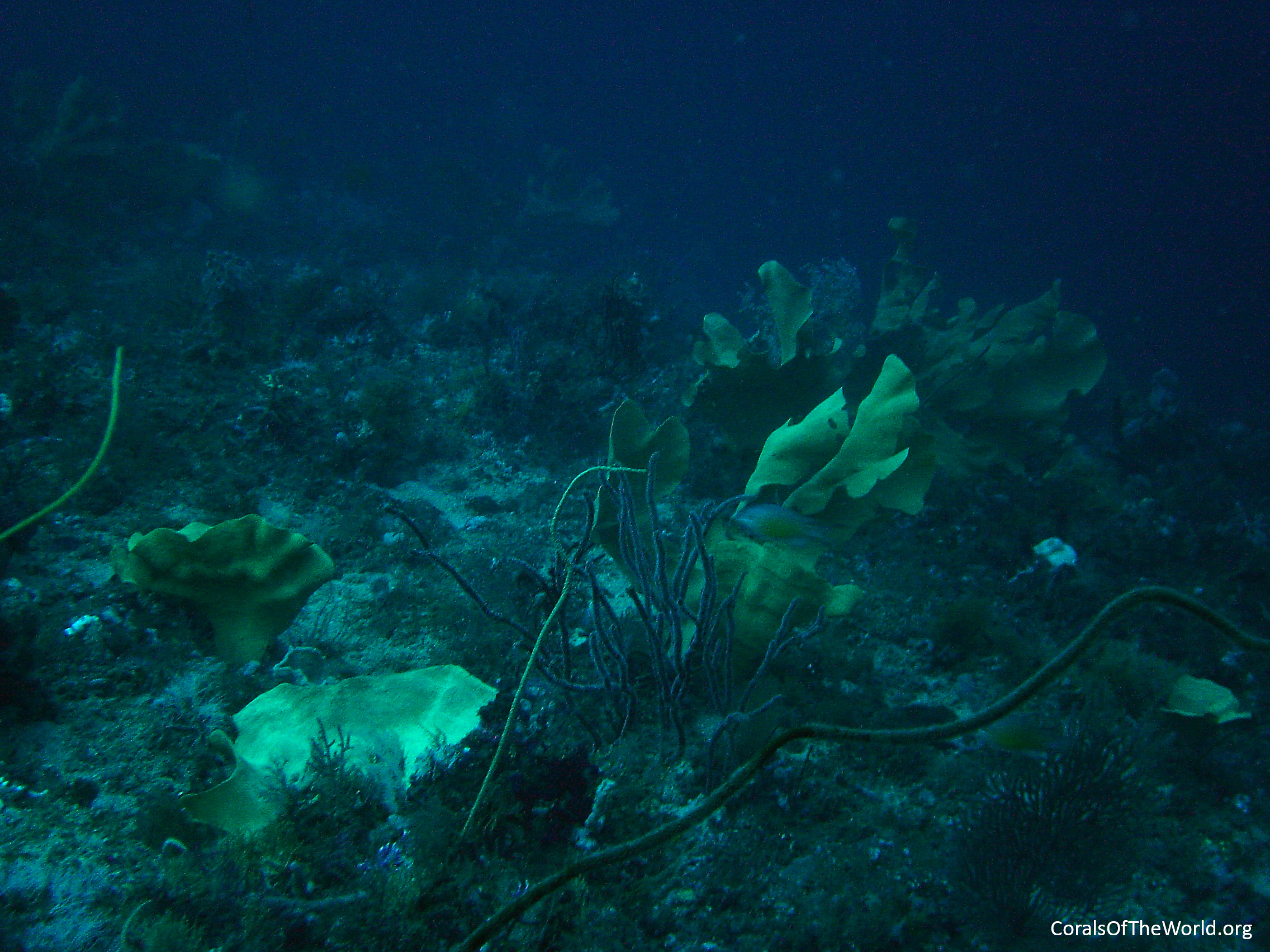
43m. Pohnpei, Micronesia Photograph: Emre Turak and Lyndon DeVantier Figure 9.
Upper mesophotic reef communities
Corals of the UMZ together form a variety of assemblage types that typically represent deeper-slope extensions of their shallower counterparts, rather than unique assemblages dominated by MZ specialists. The latter group of corals become increasingly important, however, in community structure below 60m depth, where this small group of species can occupy large expanses on lower reef slopes. Hence reef-building corals become progressively less diverse with decreasing illumination from the upper to lower MZ, as their specific physiological tolerance limits are reached.
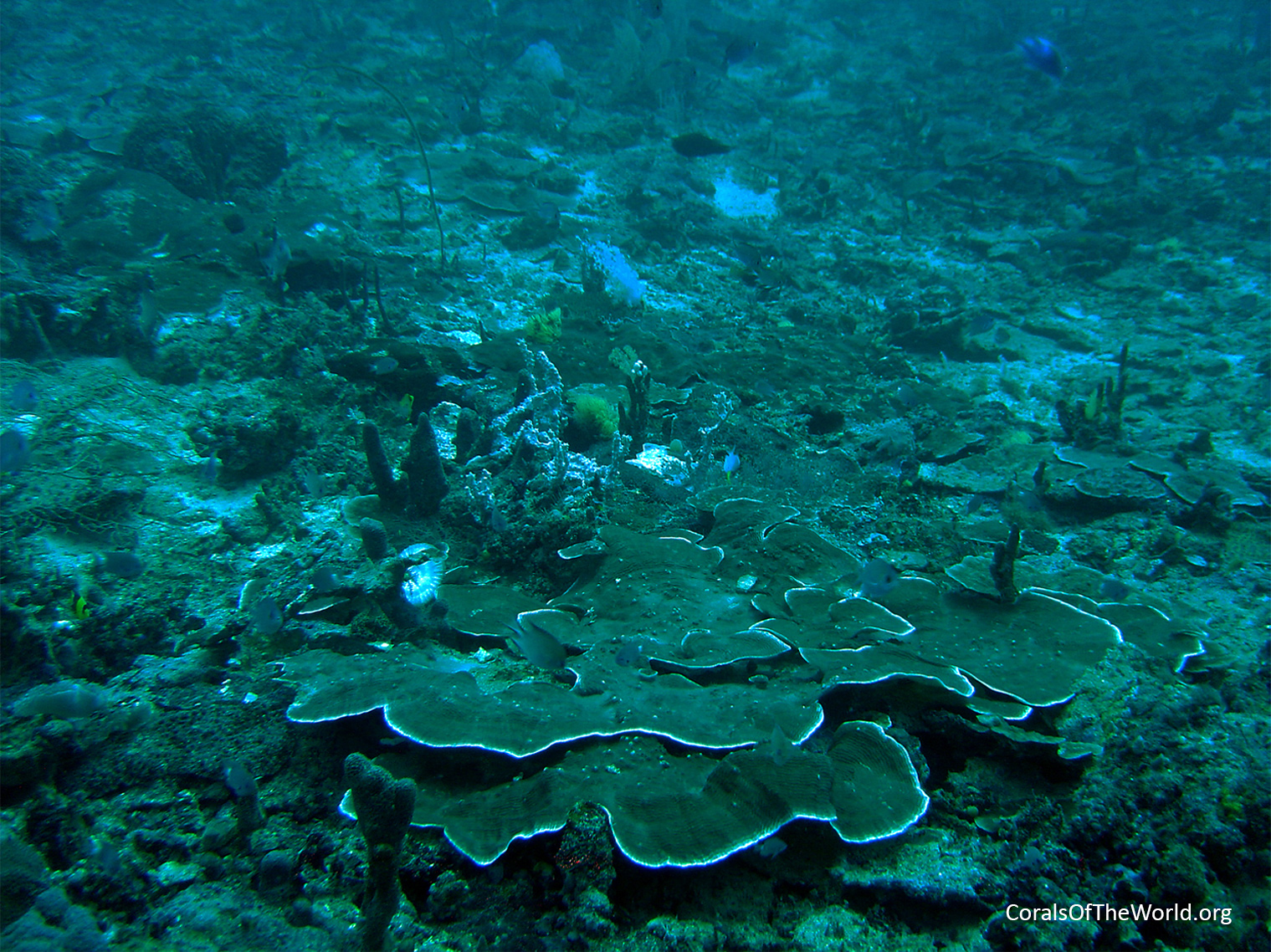
Flattened plates of Pachyseris speciosa among sparse coral cover at the base of the reef slope, 45m depth Solomon Islands Photograph: Emre Turak Figure 10.

Plating Galaxea astreata and Pavona cactus in high cover mixed coral community at 38m depth on a moderate slope Anambas Islands Photograph: Emre Turak and Lyndon DeVantier Figure 11.
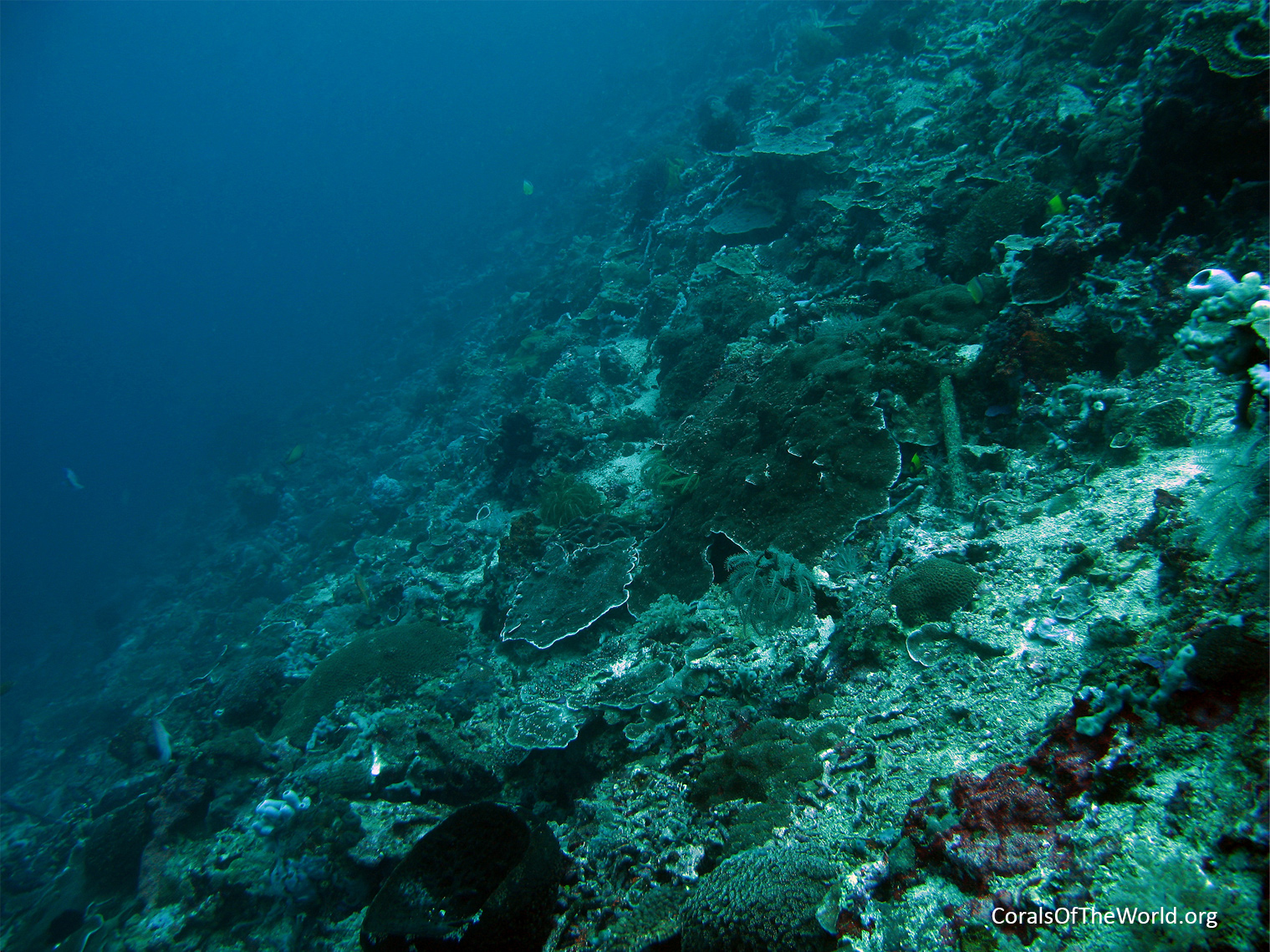
Low encrusting plate and flattened massive colonies at 38m depth on a moderately steep slope Bali, Indonesia Photograph: Emre Turak and Lyndon DeVantier Figure 12.
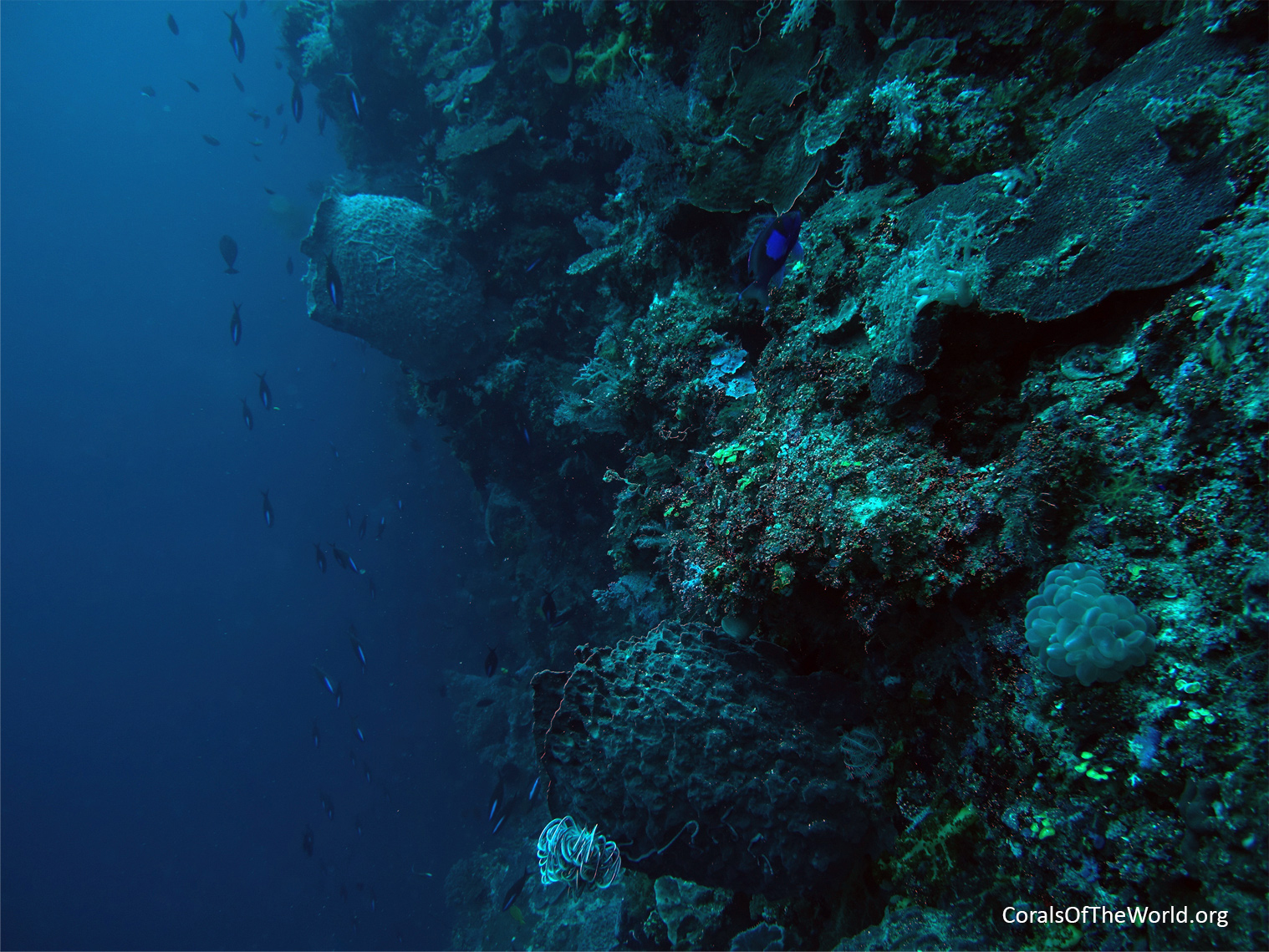
Barrel sponges and encrusting plates of Leptoseris and Favia species in species rich coral community on a very steep slope at 38m depth, Timor Leste. Note the near-horizontal orientation of barrel sponges, presumably developed in response to shading and/or competition for space from above and strong current flow Timor Leste Photograph: Emre Turak and Lyndon DeVantier Figure 13.
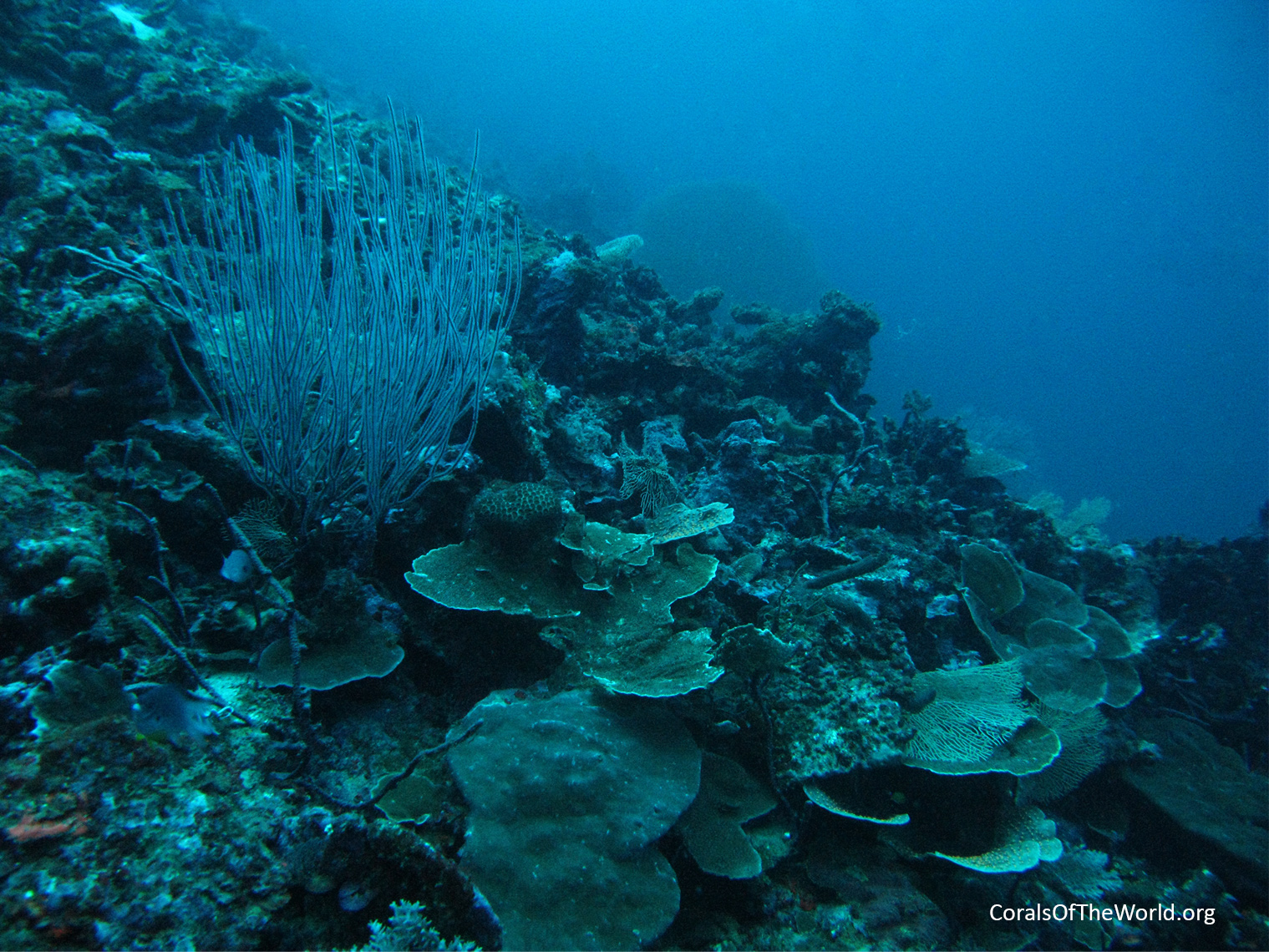
Thin plates of Mycedium, Pachyseris and Montipora species and flattened massive Porites in a species rich coral community at 39m depth on a moderately steep slope Halmahera, Indonesia Photograph: Emre Turak and Lyndon DeVantier Figure 14.

Plating colonies of massive Porites and Porites rus in clear water coral community on steep slopes at 32m depth Pohnpei, Micronesia Photograph: Emre Turak and Lyndon DeVantier Figure 15.

Mesophotic specialists
Reef-building corals can be classified into several broad groups based on specific preferences for particular depth distributions. One group of species prefers the shallow reef slope that encompasses the upper, highly illuminated few metres on reefs. Other groups of species prefer the mid to deeper reef slopes where illumination is moderate, from ca 10 to 30m depth. Another group are depth generalists, their populations broadly distributed across a wide depth range, showing no strong preference for a particular level of illumination. Finally there are the mesophotic zone specialists whose populations are mostly distributed below 30m depth. As noted above, none of the true reef-building corals, those with endo-symbiotic zooxanthellae in their tissues, occurs below the mesophotic zone. Another diverse group of non-zooxanthellate Scleractinia occupy that dark niche.
Among these groups, the MZ specialists form a very small proportion of the total reef-building coral fauna, representing less than five percent of the total species pool. A precise tally of this group is not yet available, for logistic reasons, and also because recent genetic analyses suggest that some ‘depth generalist’ species may in fact be complexes that include cryptic, sibling species in the mesophotic zone.
What is clear is that this small group of MZ specialist corals displays a wide range of life history strategies, exhibiting a high degree of niche partitioning, with specific preferences for different MZ environments.
One sub-group includes specialized sediment-tolerant corals that prefer deeper sand and rubble habitats. These areas often occur adjacent to the base of more consolidated reef slopes, and support the ecologically equivalent species Heterocyathus aequicostatus and Heteropsammia cochlea, small mushroom corals Diaseris fragilis and D. distorta and various species of Cycloseris, Acanthophyllia deshayesiana, Nemenzophyllia turbida and various species of Euphyllia, among others. Even on sandy substrates, different MZ species have particular preferences. On Australia’s Great Barrier Reef, for example Heterocyathus aequicostatus and Heteropsammia cochle are common on coarse carbonate sand but rare or absent from fine sand at the same depth (Fine, Sabbah, Shashar et al. 2013).
This is because light penetrates further in coarse rather than fine sand, and zooxanthellae on the underside of corallites can photosynthesize even when partially buried, crucial to symbiosis in these corals. Other co-occurring species, including free-living mushroom corals Cycloseris and Diaseris, may have different light-trapping strategies to assist photosynthesis on their undersides.
Other species that exploit this niche, including Nemenzophyllia turbida and several species of Euphyllia, along with Acropora cardenae and A. russelli, are less constrained by the need for light penetration into the substrate, thanks to their more upright phaceloid and branching colony morphologies. Indeed, these and other such species, including some Anacropora, often have lower portions of their colonies buried in the silty sand. Expansion of fleshy mantles in the former, phaceloid Nemenzophyllia and Euphyllia species, and the open branching patterns of the latter Anacropora and Acropora, also aid sediment rejection. Acropora cardenae, along with A. russelli and A. torihalimeda, typically occurs well below 40m depth, as attached or free-living branching colonies, the latter species among beds of the calcareous macro-algae Halimeda.
Some MZ species occur more commonly on consolidated or semi-consolidated patches of reef, where hard substrate is available for larval settlement. Those preferring gentle to moderate reef slopes include the plating Acropora elegans, A. simplex, A. pichoni, A. fragilis and A. tenella.
Other species that commonly occur in the MZ prefer steeper reef walls, or other habitats with high rugosity. These include various encrusting, plating and foliaceous species of Leptoseris, notably L. hawaiiensis, L. scabra, L. solida, L. foliosa, L. amitoriensis, L. gardineri and L. tubulifera. Some species of Leptoseris are among the deepest-occurring of all zooxanthellate Scleractinia, and also have extraordinarily broad depth ranges. When living on shallower parts of reefs, these species, and some other MZ specialists like Craterastrea levis, typically prefer low-light habitats, such as around the bases of large massive corals or reef blocks or under overhangs.
Typical growth-forms of upper mesophotic specialists
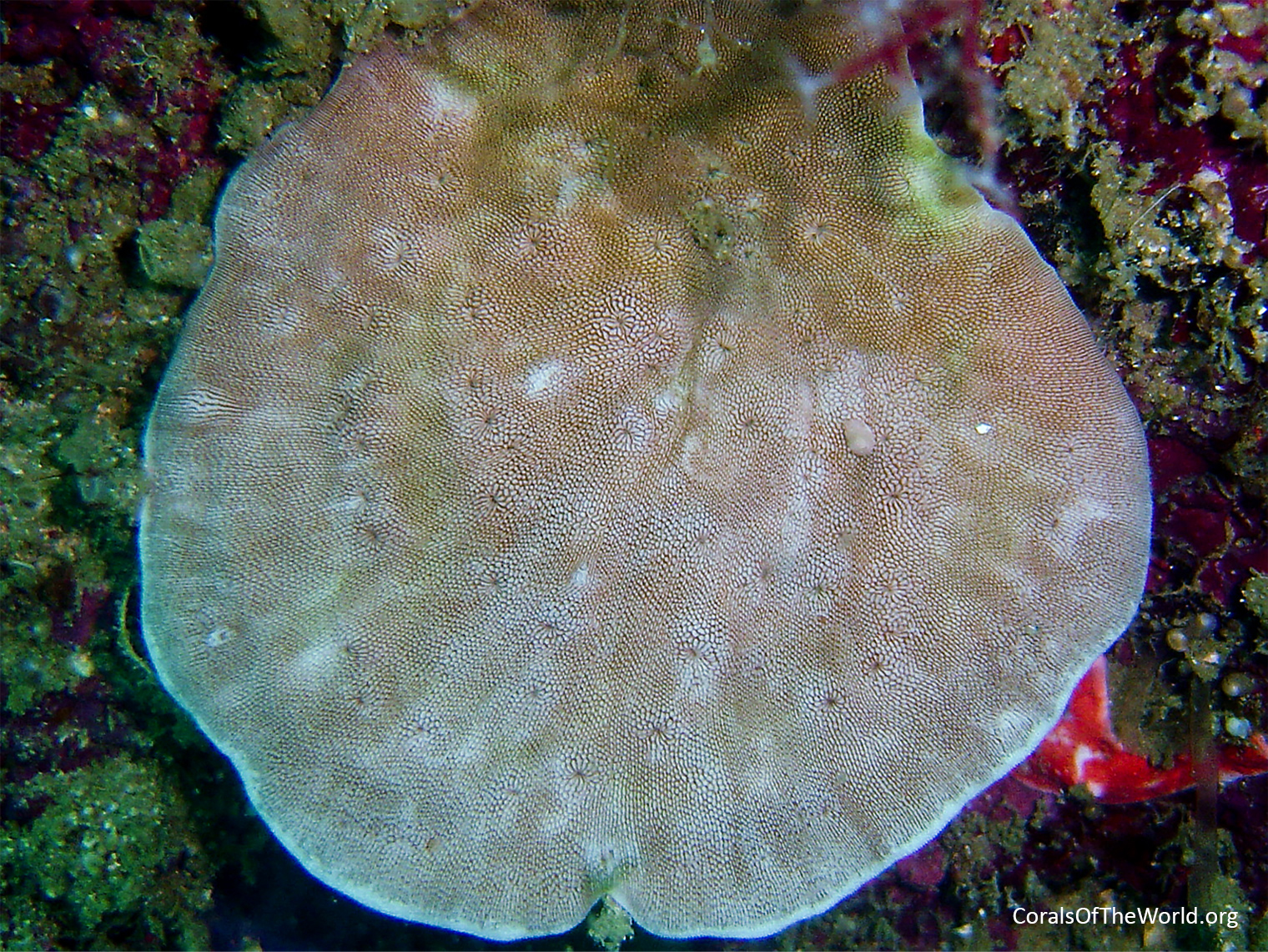
Single solid plate in Craterastrea levis at 31m depth Fakfak-Kaimana, Papua, Indonesia Photograph: Emre Turak and Lyndon DeVantier Figure 16.

Tiered plates in Leptoseris amitoriensis at 30m depth Raja Ampat, Indonesia Photograph: Emre Turak and Lyndon DeVantier Figure 17.
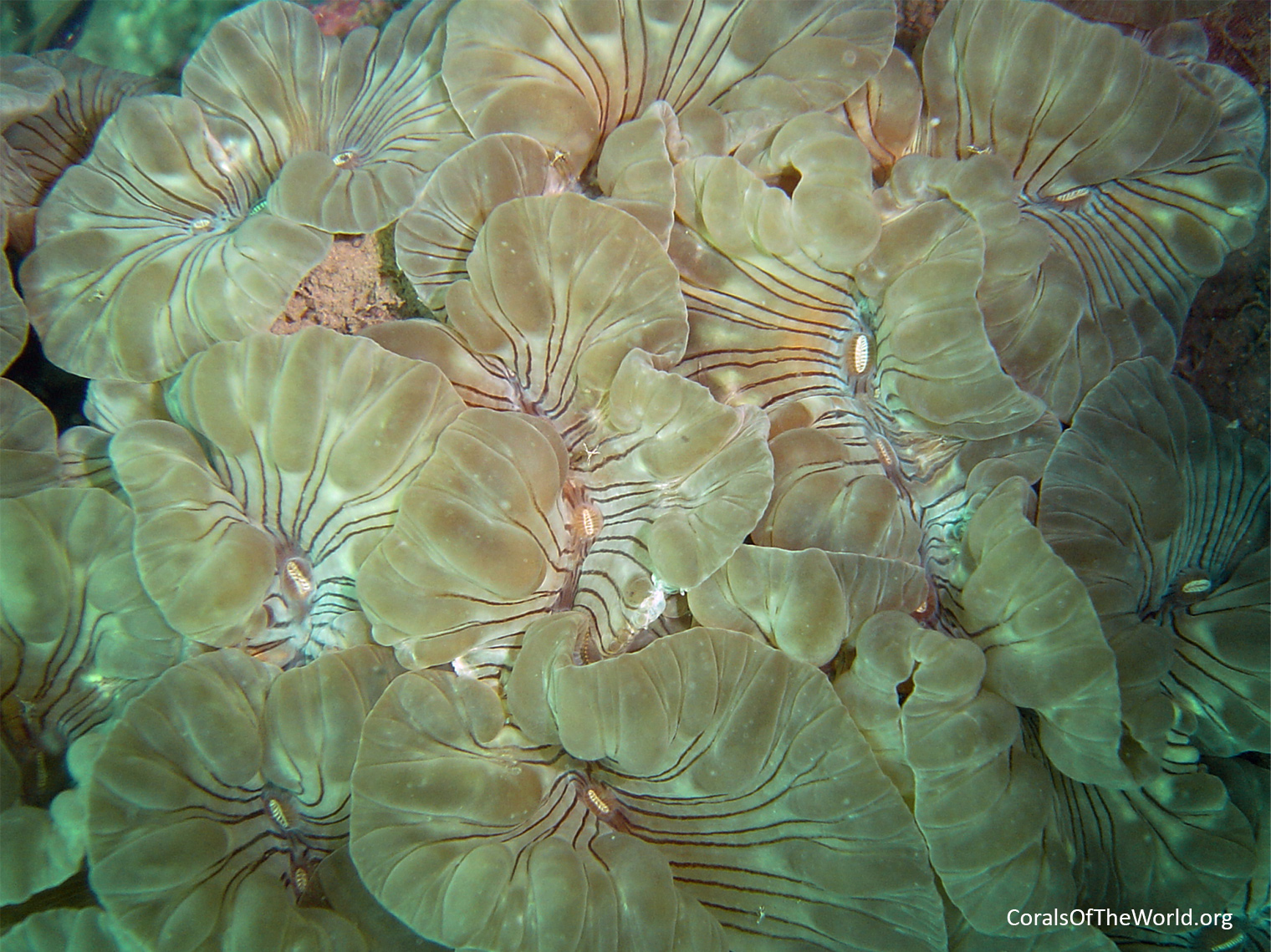
Flabello-meandroid form underlying inflated mantles in Nemenzophyllia turbida at 33m depth Raja Ampat, Indonesia Photograph: Emre Turak Figure 18.
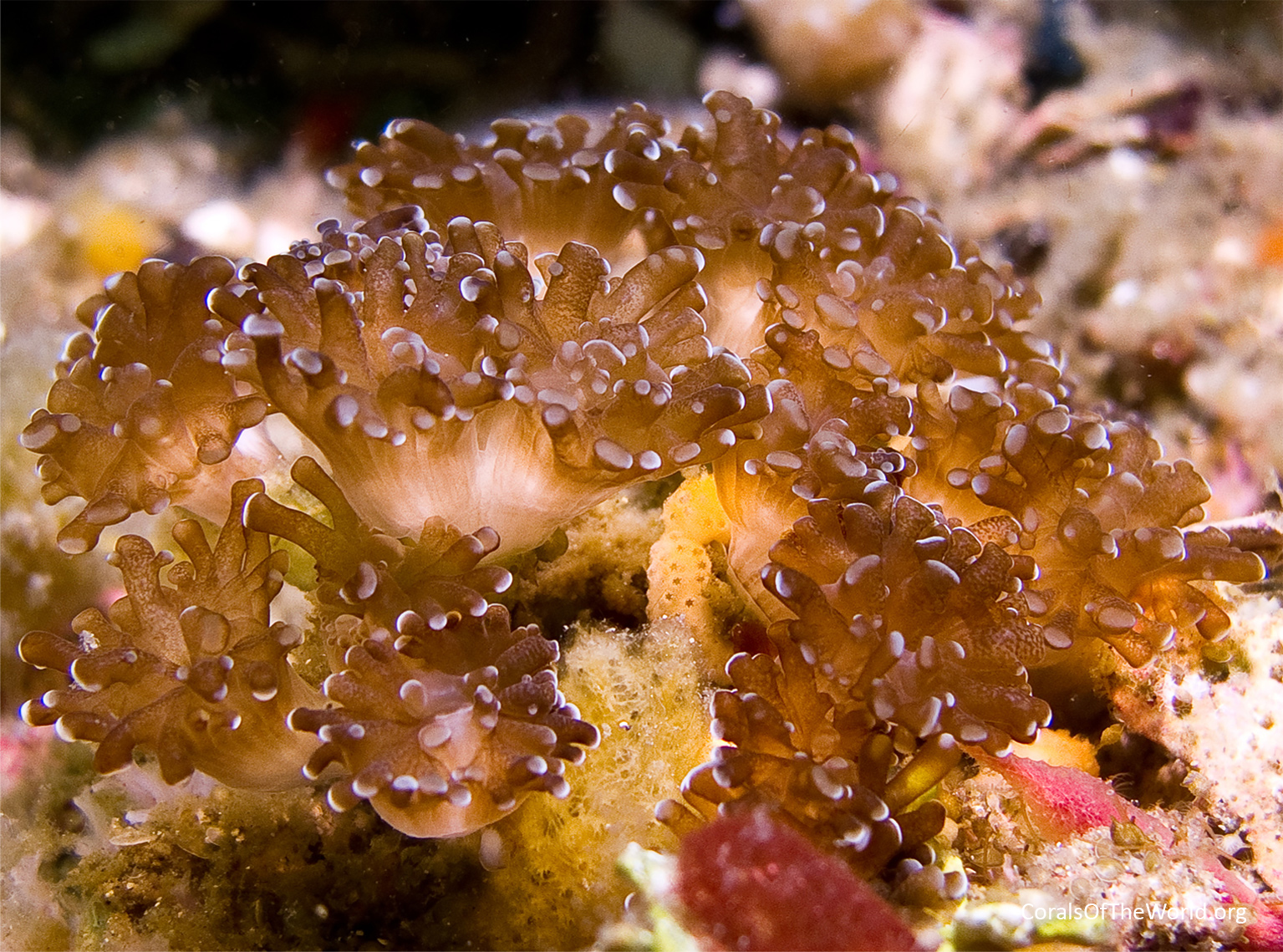
Phaceloid form underlying inflated mantles and tentacles in Euphyllia baliensis at 30m Bali, Indonesia Photograph: Emre Turak and Lyndon DeVantier Figure 19.
Rare occurrences of mesophotic specialists in shallower water
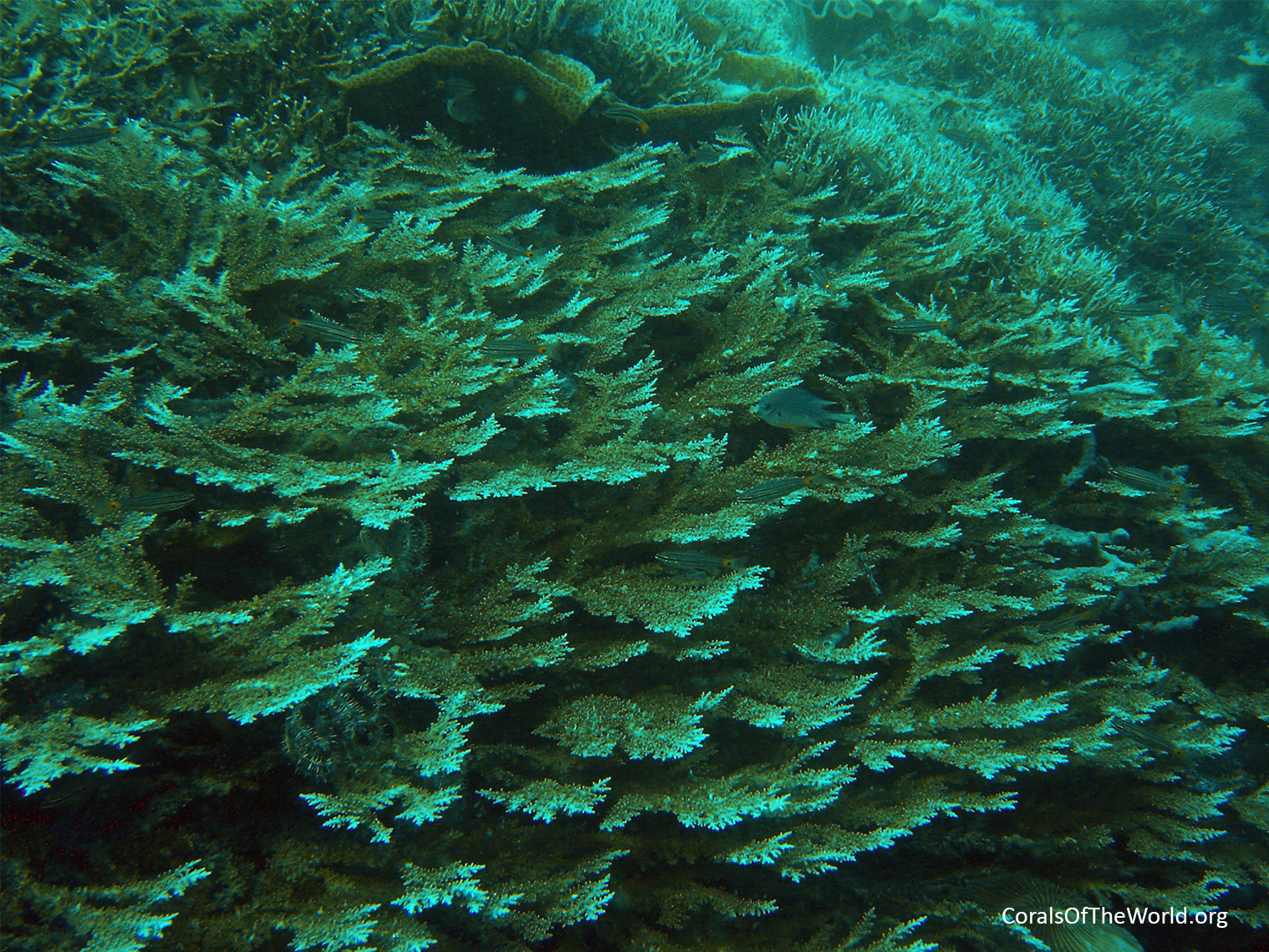
Acropora tenella at 15m depth Manus Island, Papua New Guinea Photograph: Emre Turak Figure 20.
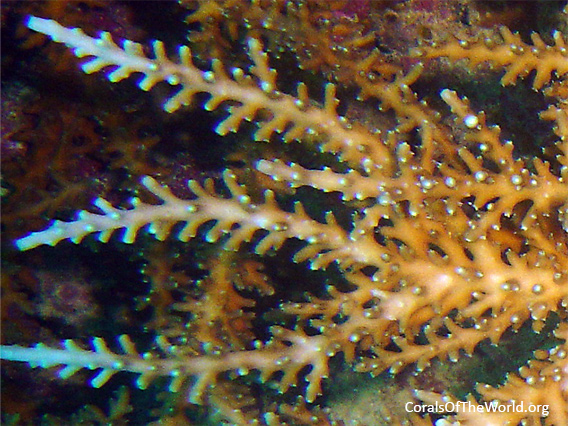
Acropora tenella closeup Manus Island, Papua New Guinea Photograph: Emre Turak and Lyndon DeVantier Figure 21.
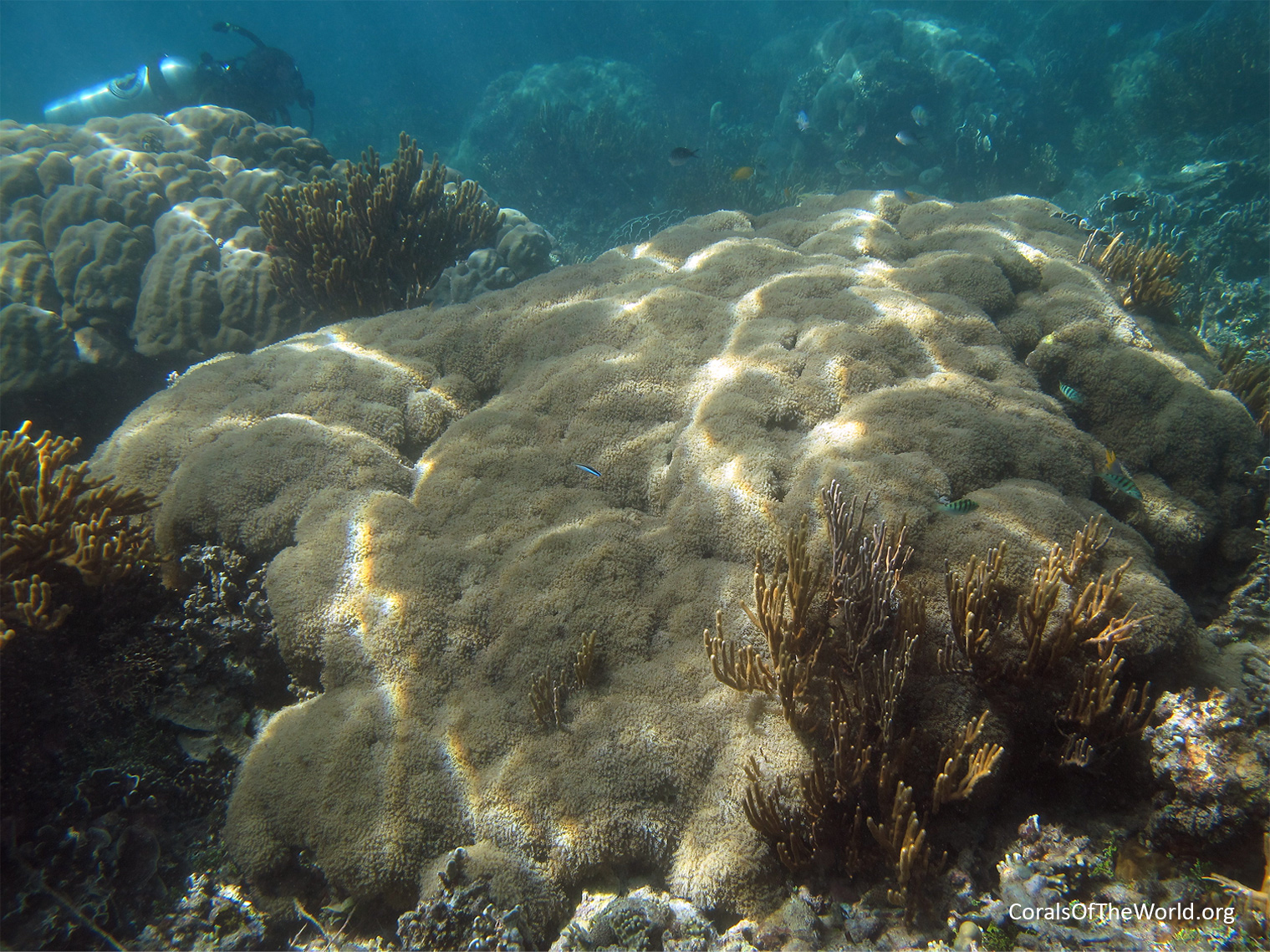
Euphyllia paradivisa at 6m depth Timor Leste Photograph: Emre Turak and Lyndon DeVantier Figure 22.
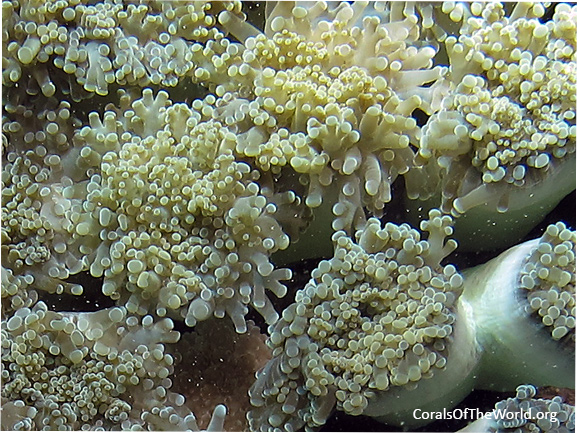
Euphyllia paradivisa closeup Timor Leste Photograph: Emre Turak and Lyndon DeVantier Figure 23.
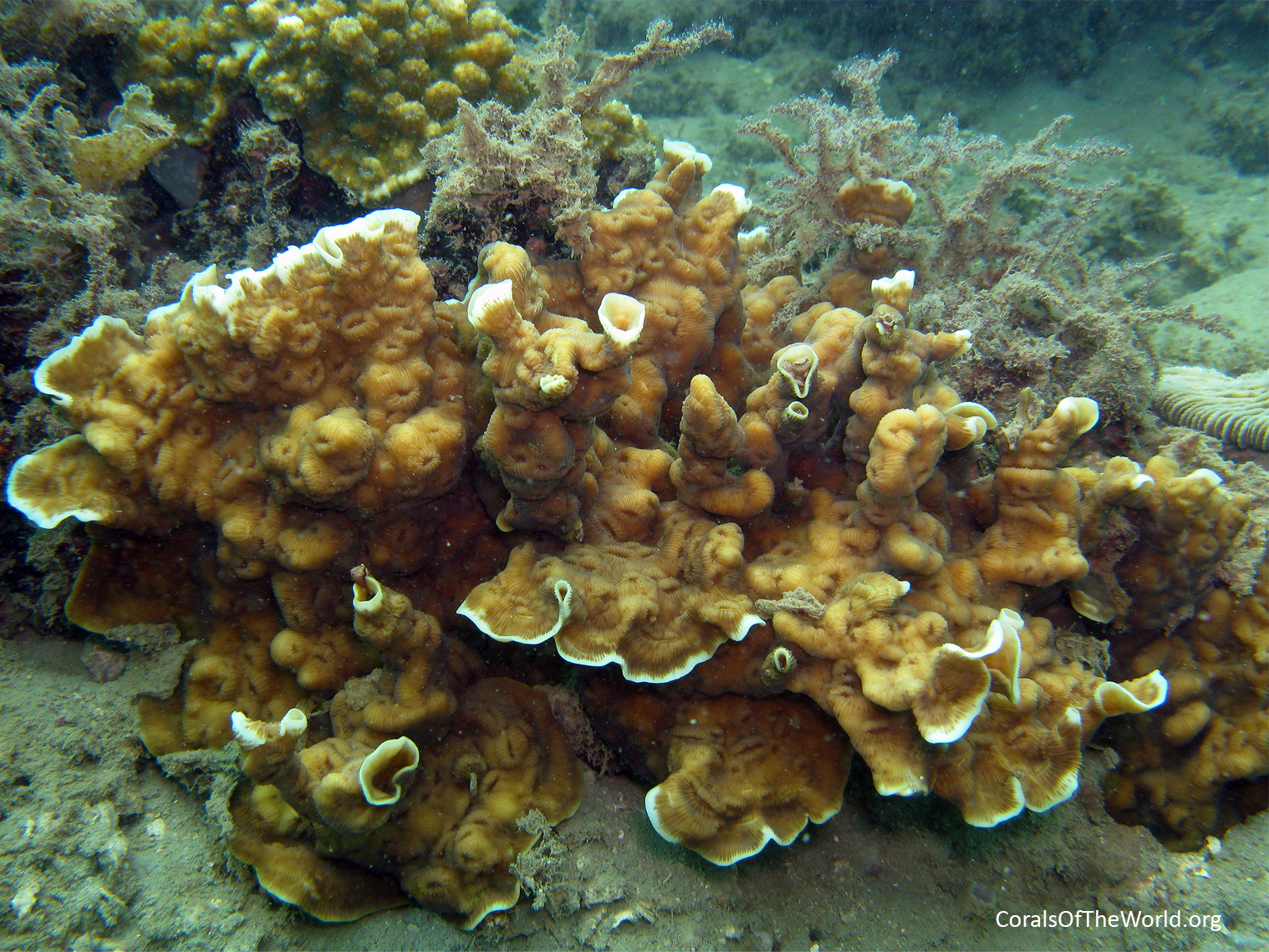
Leptoseris scabra at 5m depth El Nido, Philippines Photograph: Emre Turak and Lyndon DeVantier Figure 24.
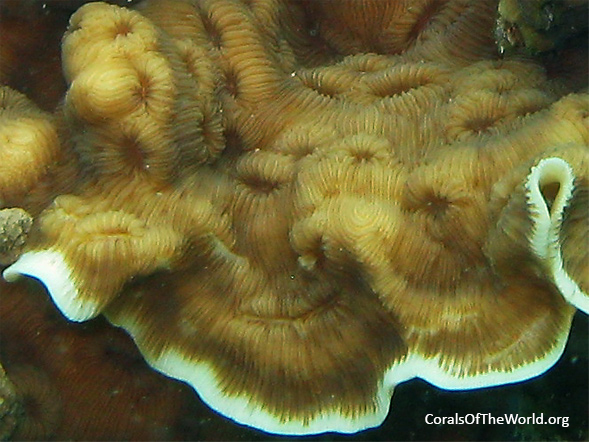
Leptoseris scabra closeup El Nido, Philippines Photograph: Emre Turak and Lyndon DeVantier Figure 25.
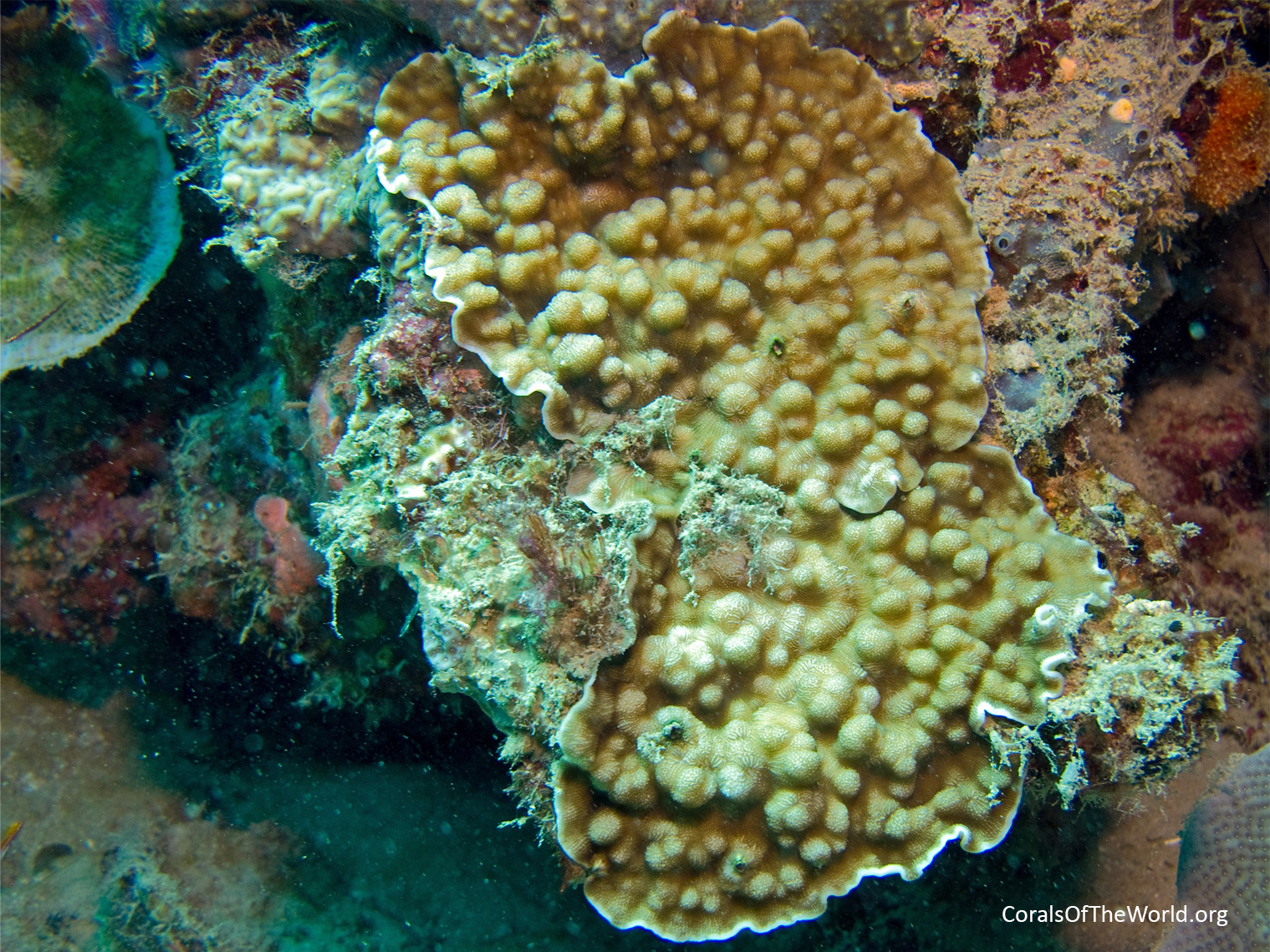
Leptoseris solida at 14m depth Timor Leste Photograph: Emre Turak and Lyndon DeVantier Figure 26.
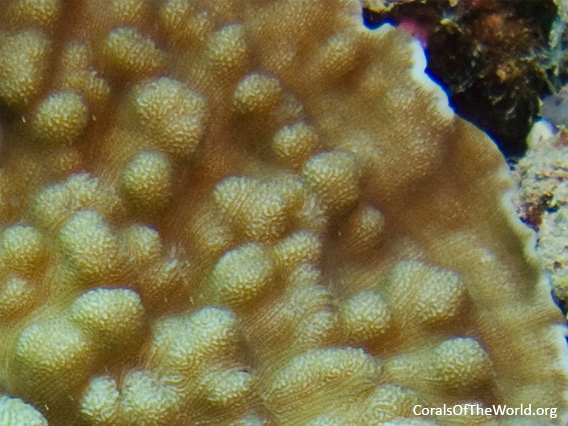
Leptoseris solida closeup Timor Leste Photograph: Emre Turak and Lyndon DeVantier Figure 27.
High coral cover of multi- and monospecific coral beds in the upper mesophotic zone
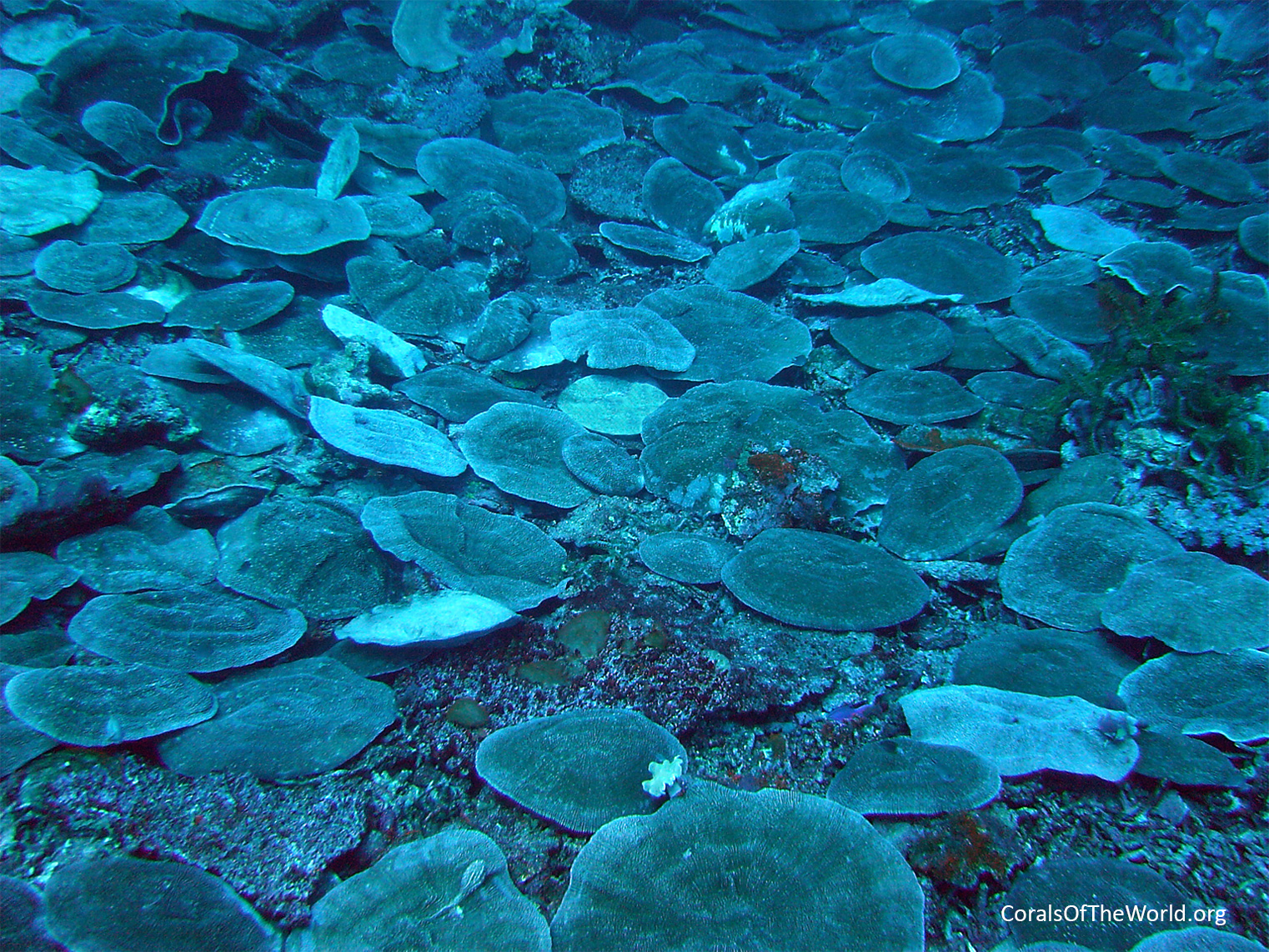
Mixed fungiid assemblage dominated by Zoopilus echinatus at 50m depth Kimbe Bay, Bismarck Sea Photograph: Emre Turak Figure 28.

Monospecific Acropora tenella beds extending down-slope from 43m depth Kimbe Bay, Bismarck Sea Photograph: Emre Turak Figure 29.
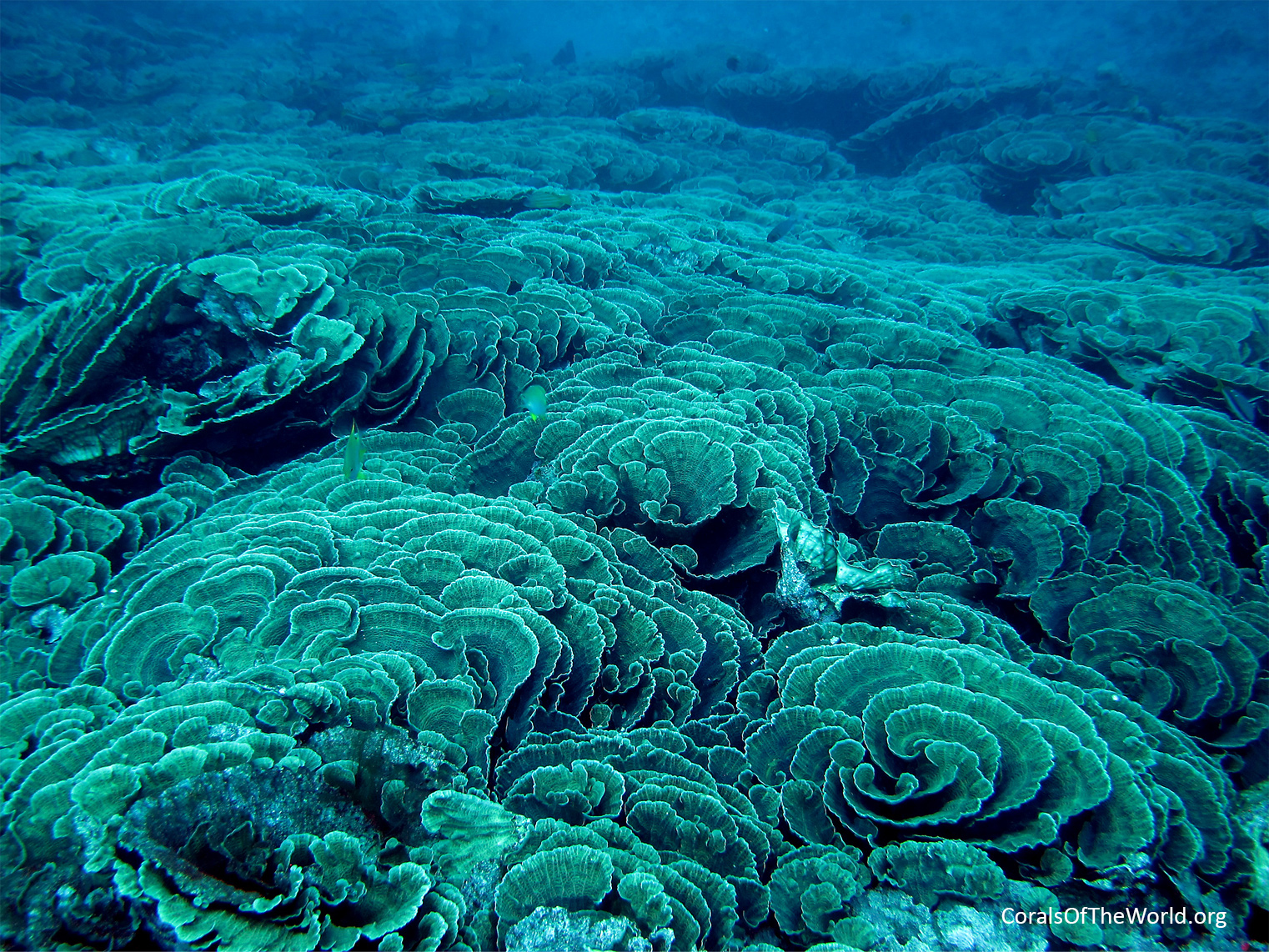
Monospecific Leptoseris yabei beds extending down-slope from 37m depth Anambas Islands, Indonesia Photograph: Emre Turak and Lyndon DeVantier Figure 30.

Acropora muricata beds and in the background plating Porites rus covering the slopes at 40m depth Pohnpei, Micronesia Photograph: Emre Turak and Lyndon DeVantier Figure 31.

Morphological adaptation with depth
Porites
Species of Porites that typically form boulder-shaped massive colonies exhibit a broad capacity for modifying growth-form in respect of ambient conditions. In the inter-tidal zone these typically grow into ‘micro-atolls’, constrained on their upper surfaces by low tide level, while spreading outward from their exposed edges. Sub-tidally, they form hemispherical boulders in lagoons and on reef slopes, becoming progressively more flattened with increasing depth and / or decreasing illumination, ultimately becoming plating on lower reef slopes below 30m.
Below are various morphologies of ‘massive Porites’ illustrating progressive flattening towards plating growth-form with increasing depth. Sampling of illustrated colonies (required for definitive identification) was not undertaken but, of the six massive Porites species from the central Indo-west Pacific that attain large size, at least three (P. lutea, P. lobata and P. solida) are known to display this range of morphologies.
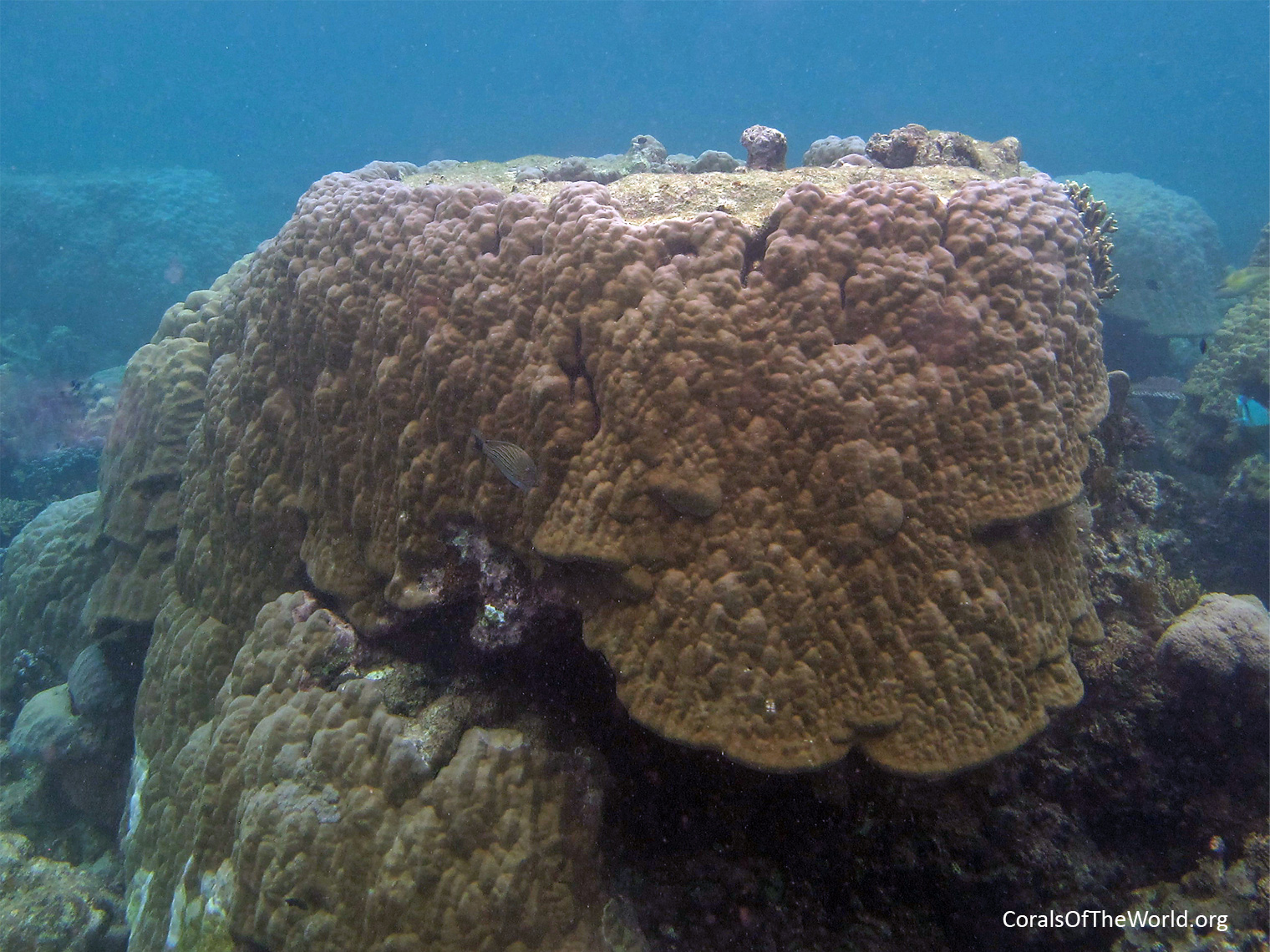
Massive Porites. Shallow sub-intertidal area, with top of colony adopting typical ‘micro-atoll’ shape, fringing reef flat Anambas Islands, Indonesia Photograph: Emre Turak and Lyndon DeVantier Figure 32.
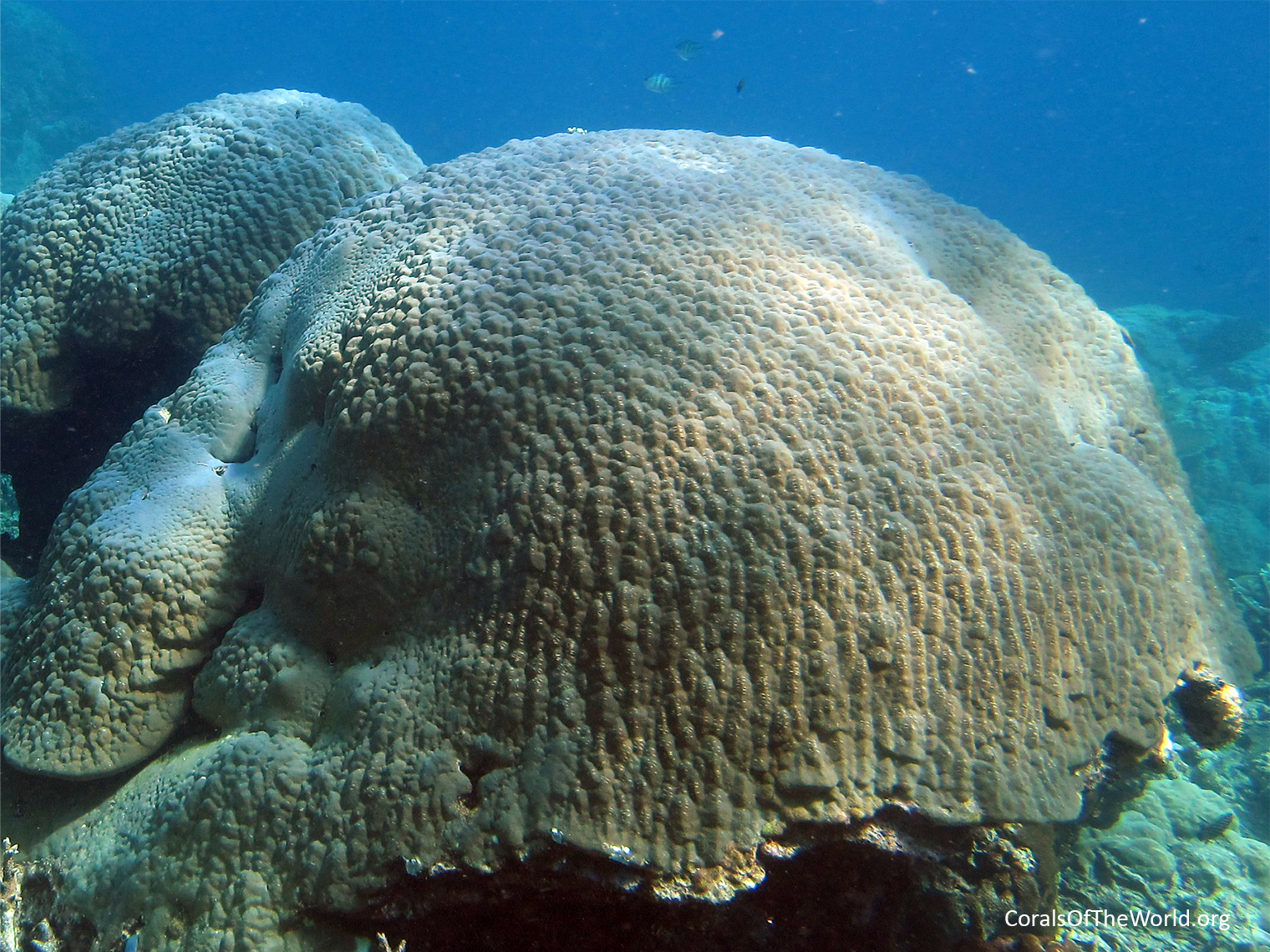
Massive Porites. Colony base at 5-7m depth, fringing reef Anambas Islands, Indonesia Photograph: Emre Turak and Lyndon DeVantier Figure 33.

Massive Porites. Typical mid-slope colony form at 15m depth, with development of ledges around the colony sides and evidence of prior fragmentation around the colony base, fringing reef Bali, Indonesia Photograph: Emre Turak and Lyndon DeVantier Figure 34.

Massive Porites. More flattened colony form at 20m depth, patch reef Brunei Darussalam Photograph: Emre Turak and Lyndon DeVantier Figure 35.
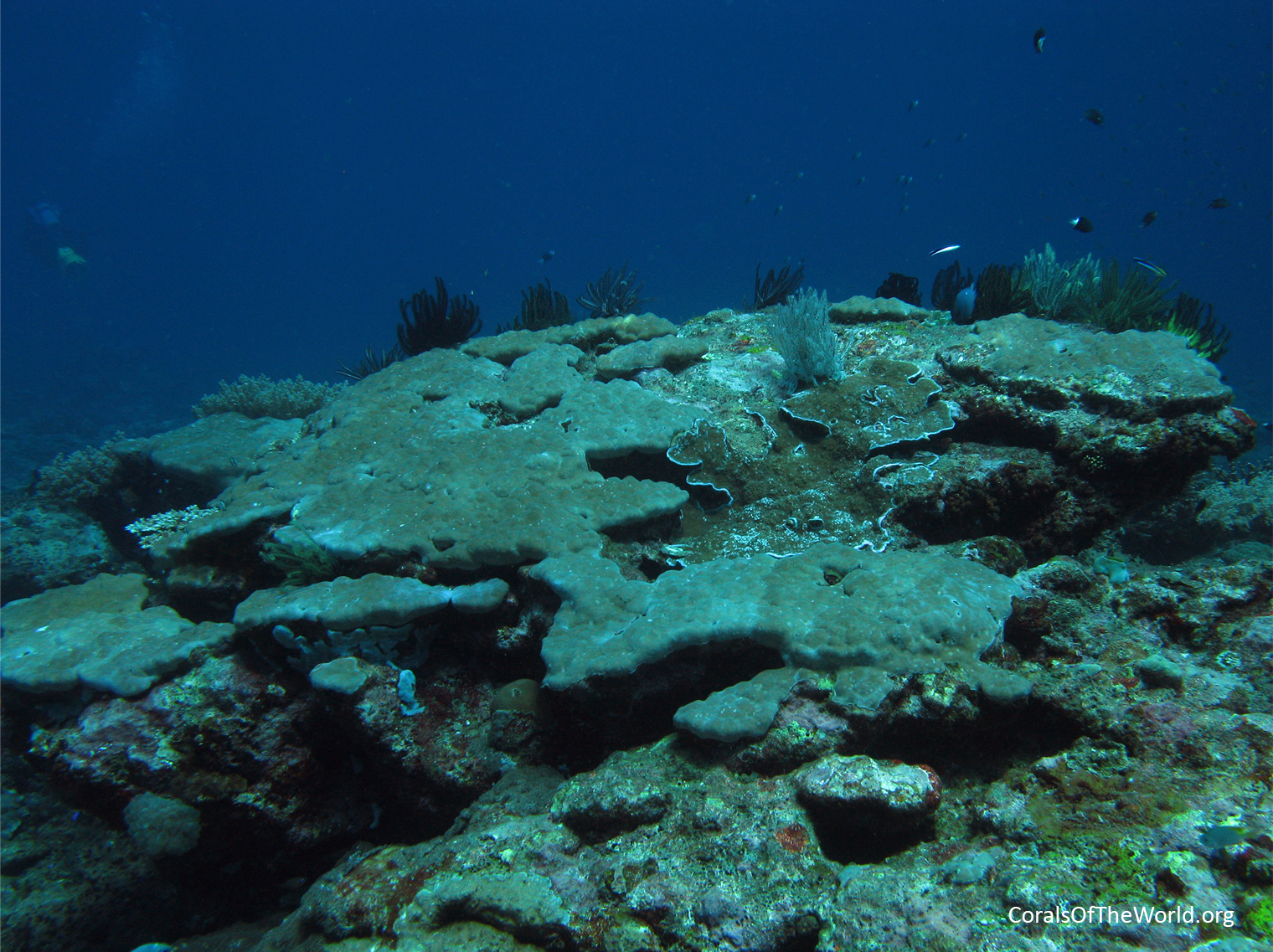
Massive Porites. Increased flattening and plate formation at 29m depth, submerged patch reef Brunei Darussalam Photograph: Emre Turak and Lyndon DeVantier Figure 36.
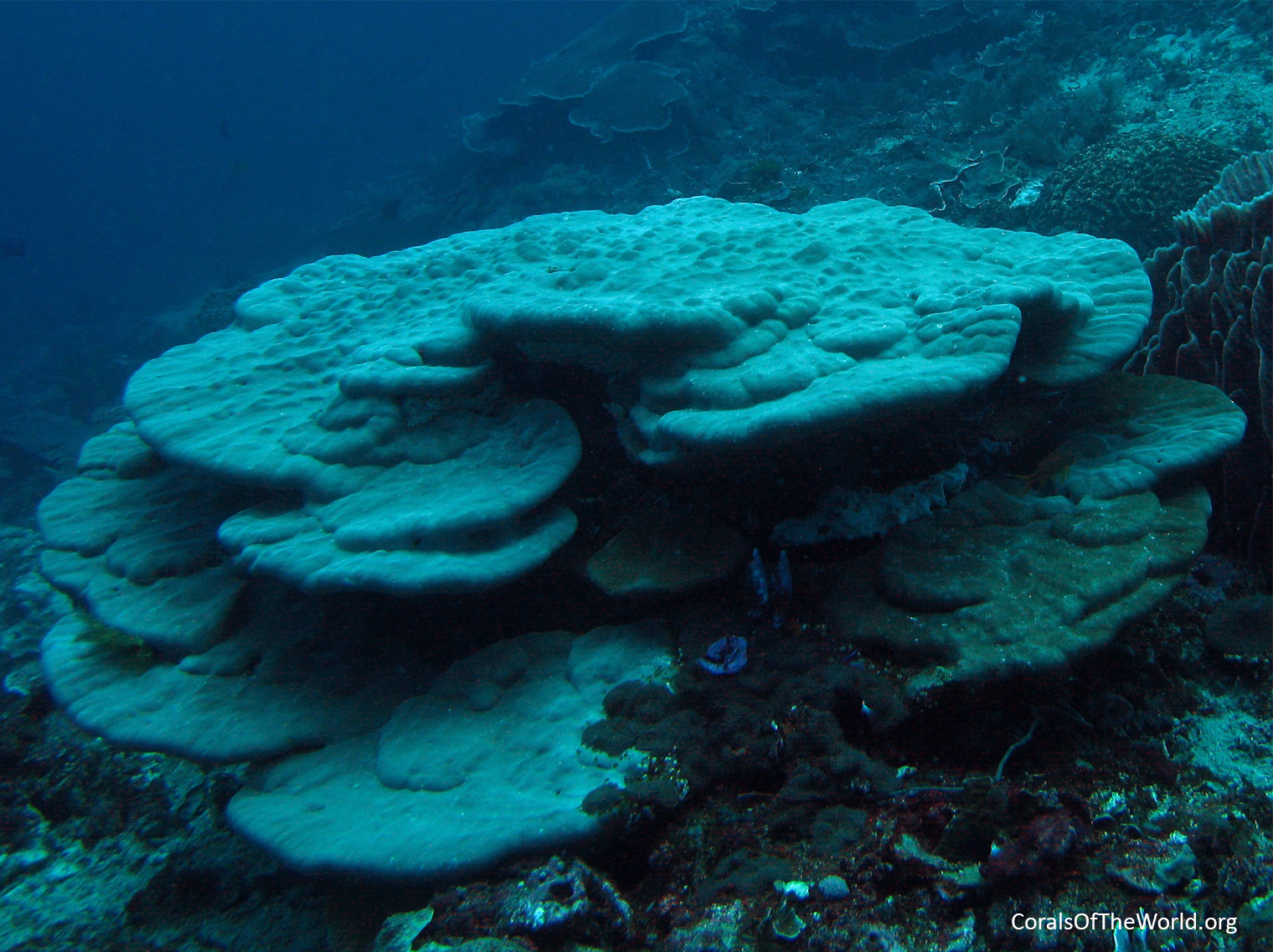
Massive Porites. Tiered plating form at 35m depth, fringing reef Bali, Indonesia Photograph: Emre Turak and Lyndon DeVantier Figure 37.
Acropora
Three species of upper mesophotic zone Acropora of the central Indo-west Pacific showing various levels of table flattening and branch fusion at depth. All upper mesophotic zone Acropora species typically have a mustard yellow-brown colour in situ, and presumably host a symbiont suite of zooxanthellae adapted to low light conditions.
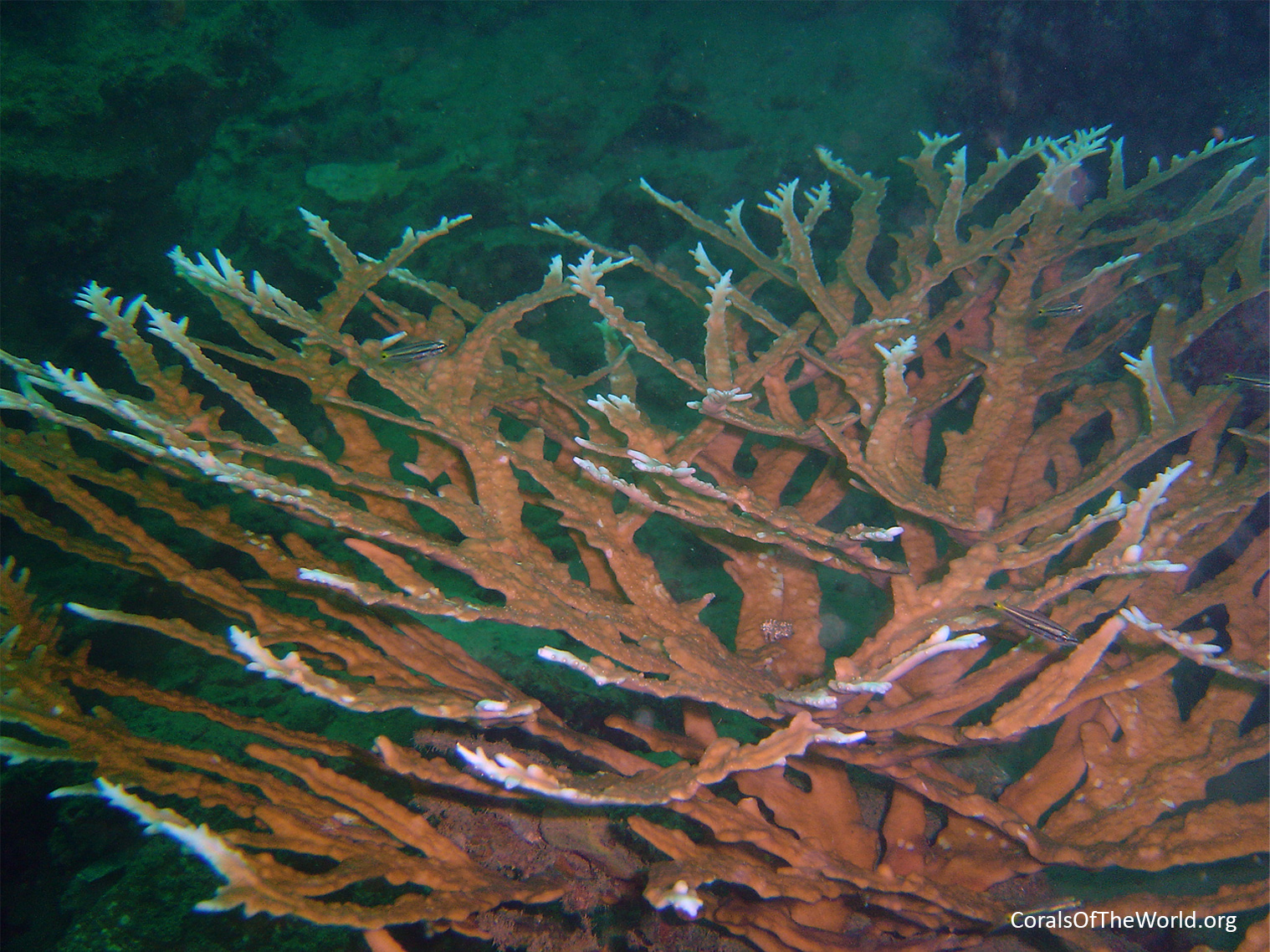
Acropora pichoni at approximately 18m depth Pohnpei, Micronesia Photograph: Emre Turak and Lyndon DeVantier Figure 38.
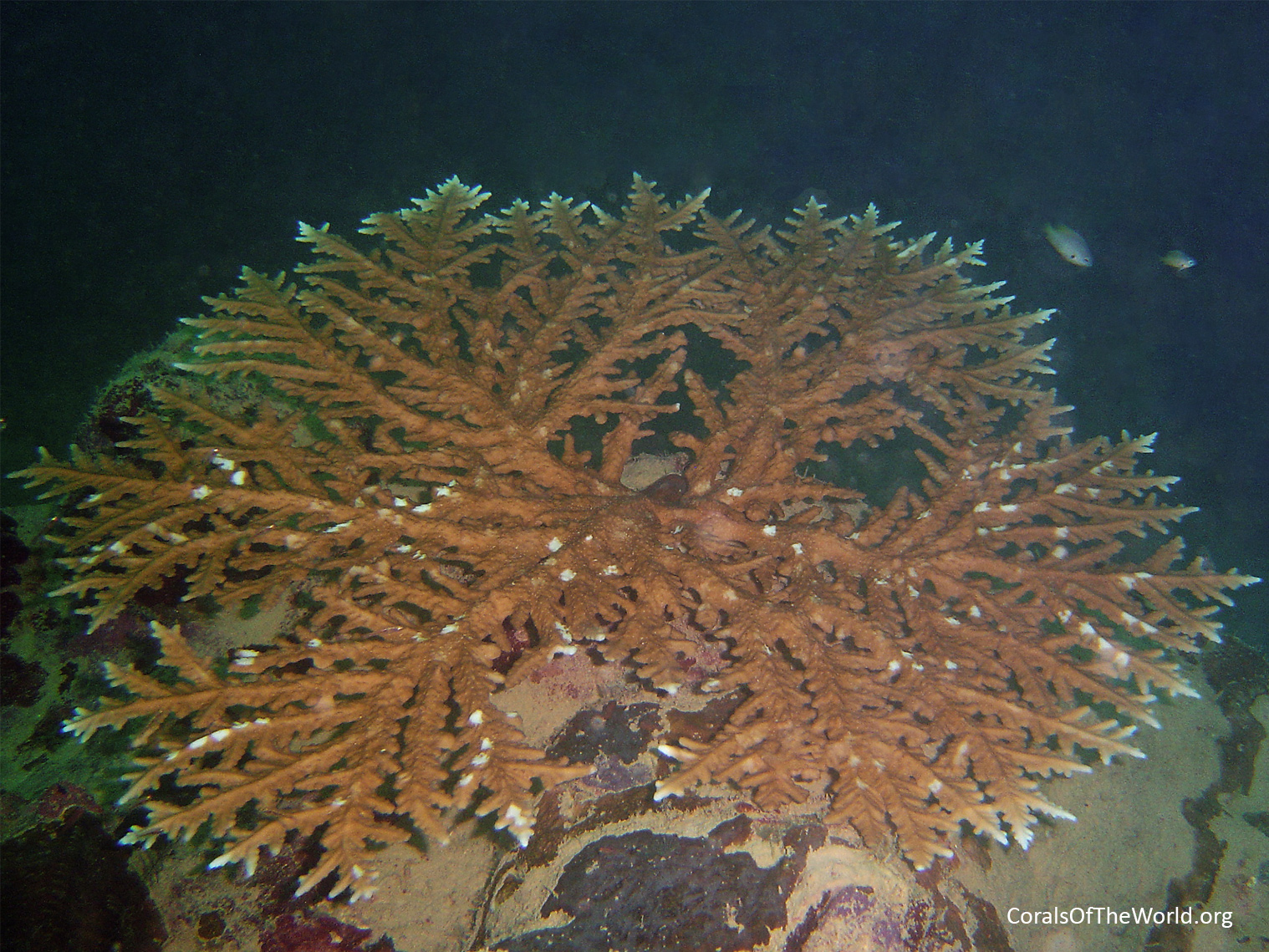
Acropora pichoni at approximately 25m depth Manus Island, Papua New Guinea Photograph: Emre Turak Figure 39.
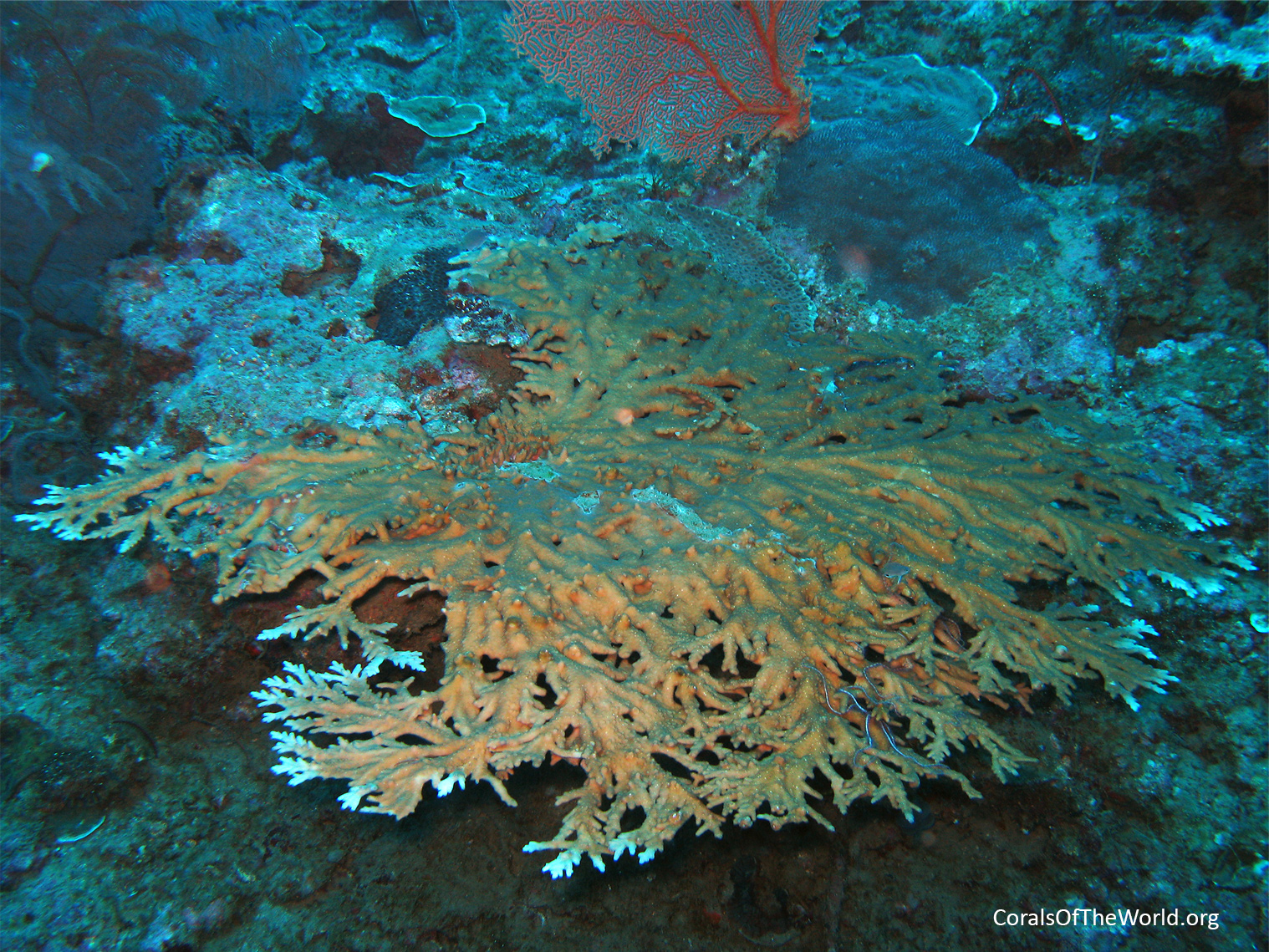
Acropora pichoni at 38m depth in clear water Brunei Darussalam Photograph: Emre Turak and Lyndon DeVantier Figure 40.

Acropora elegans at 27m depth Brunei Darussalam Photograph: Emre Turak and Lyndon DeVantier Figure 41.
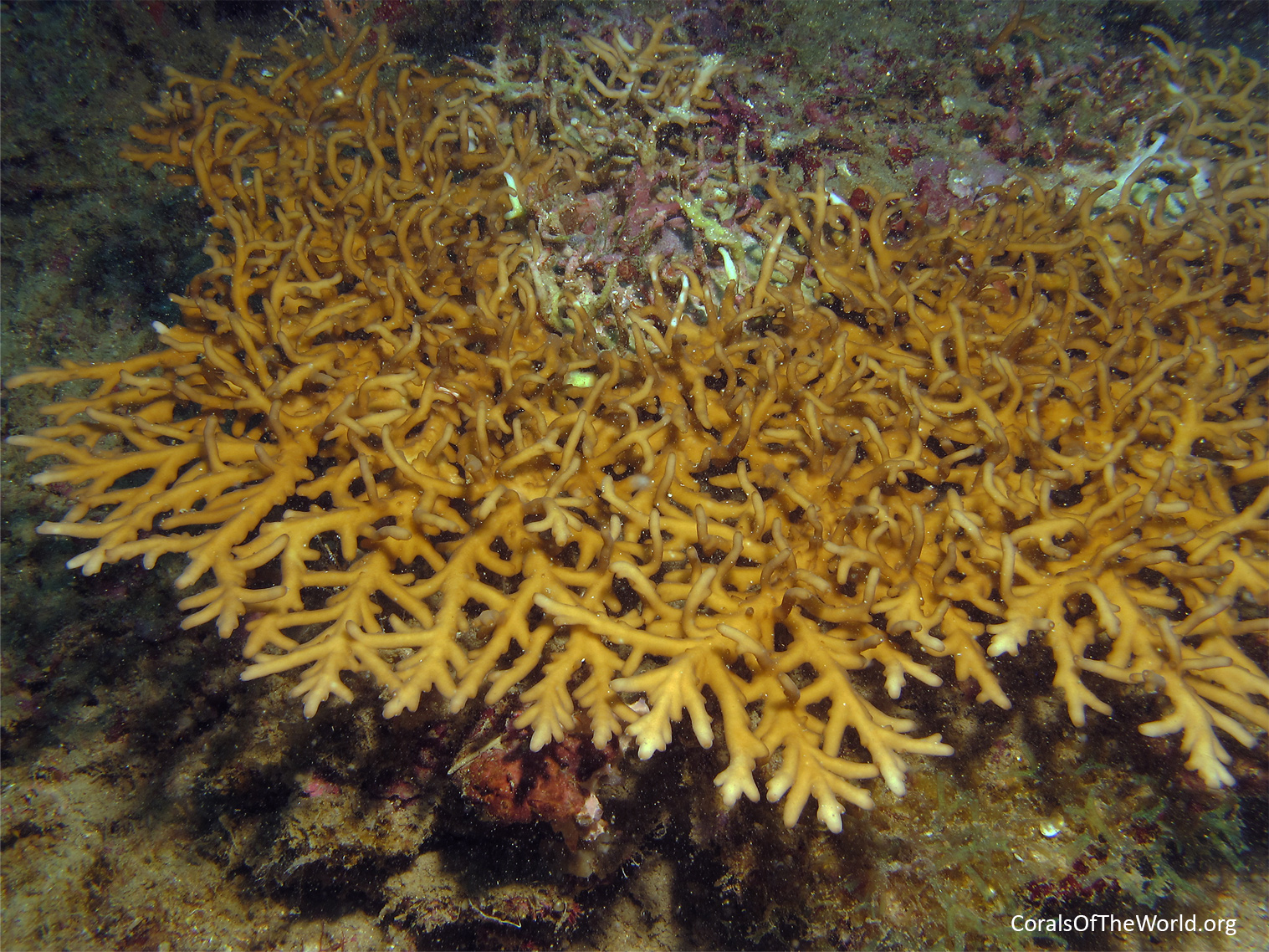
Acropora elegans at 34m depth Brunei Darussalam Photograph: Emre Turak and Lyndon DeVantier Figure 42.
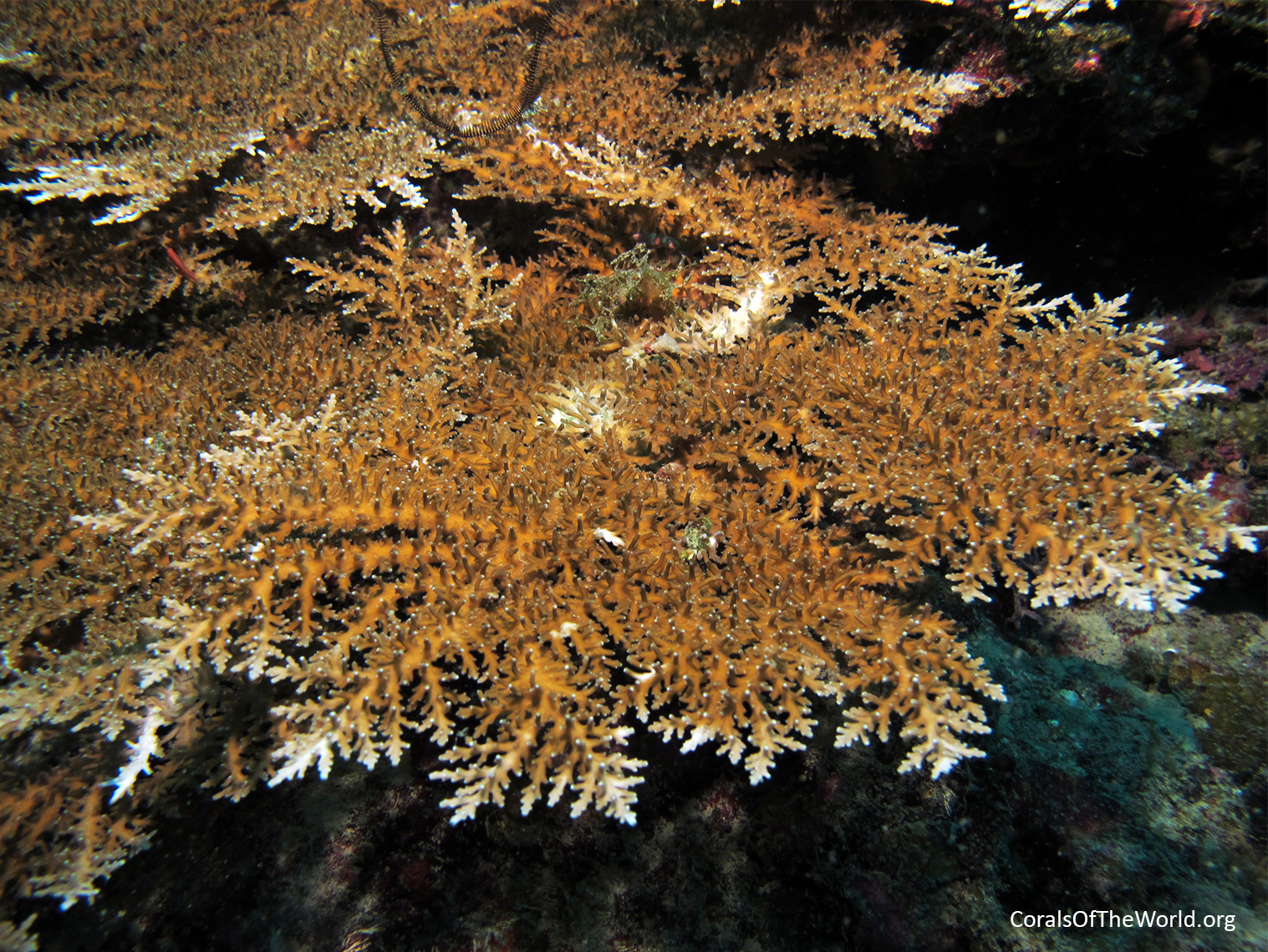
Acropora tenella at 42m depth Northern Great Barrier Reef, Australia Photograph: Emre Turak Figure 43.
Deep water adaptation of shallow water species
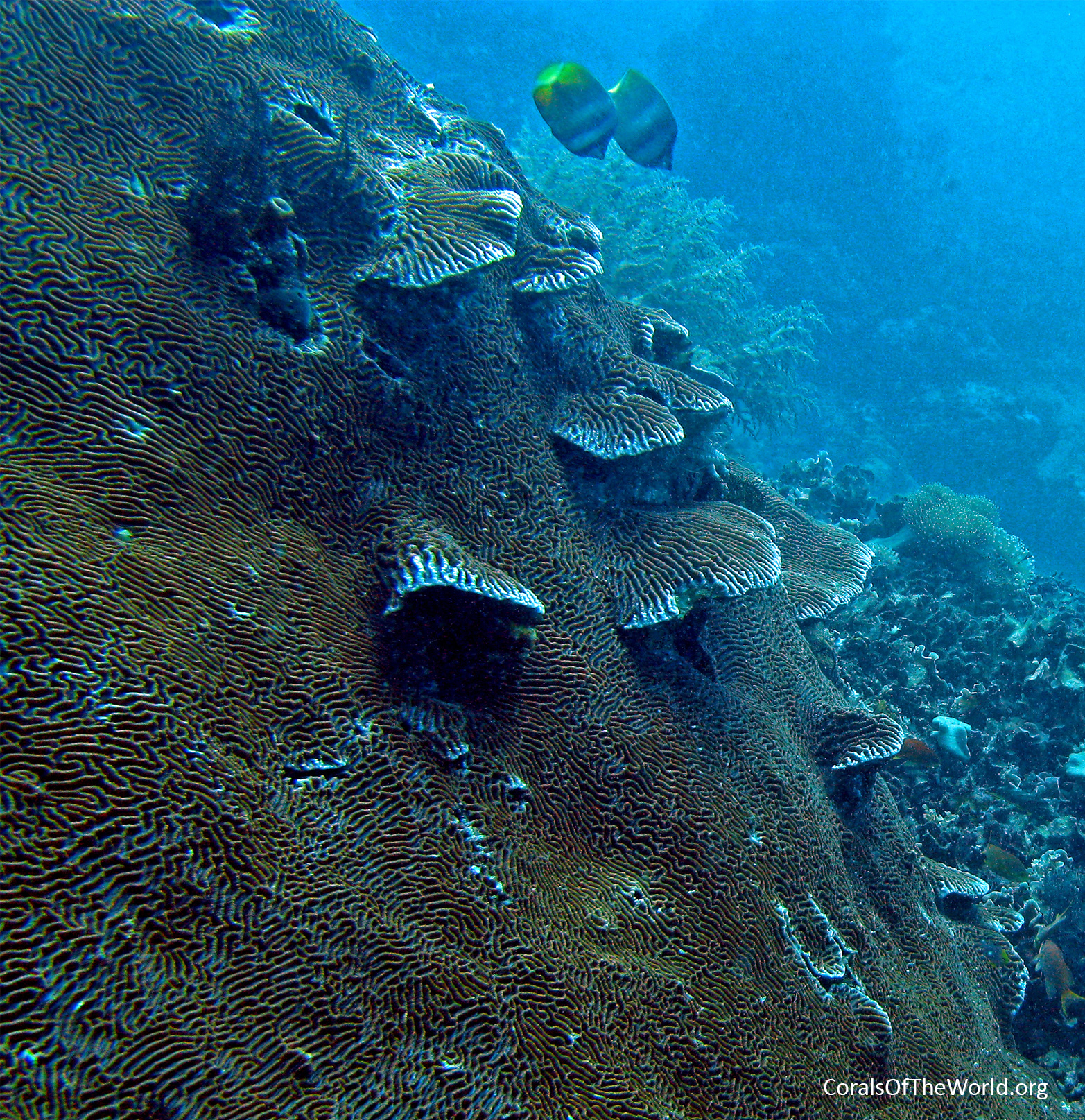
Development of flared ledges around the side of a large massive colony of Platygyra daedalea at 35m depth. Episodic detachment of ledges facilitates local dispersal of ramets (DeVantier and Endean, 1989) Halmahera, Indonesia Photograph: Emre Turak and Lyndon DeVantier Figure 44.
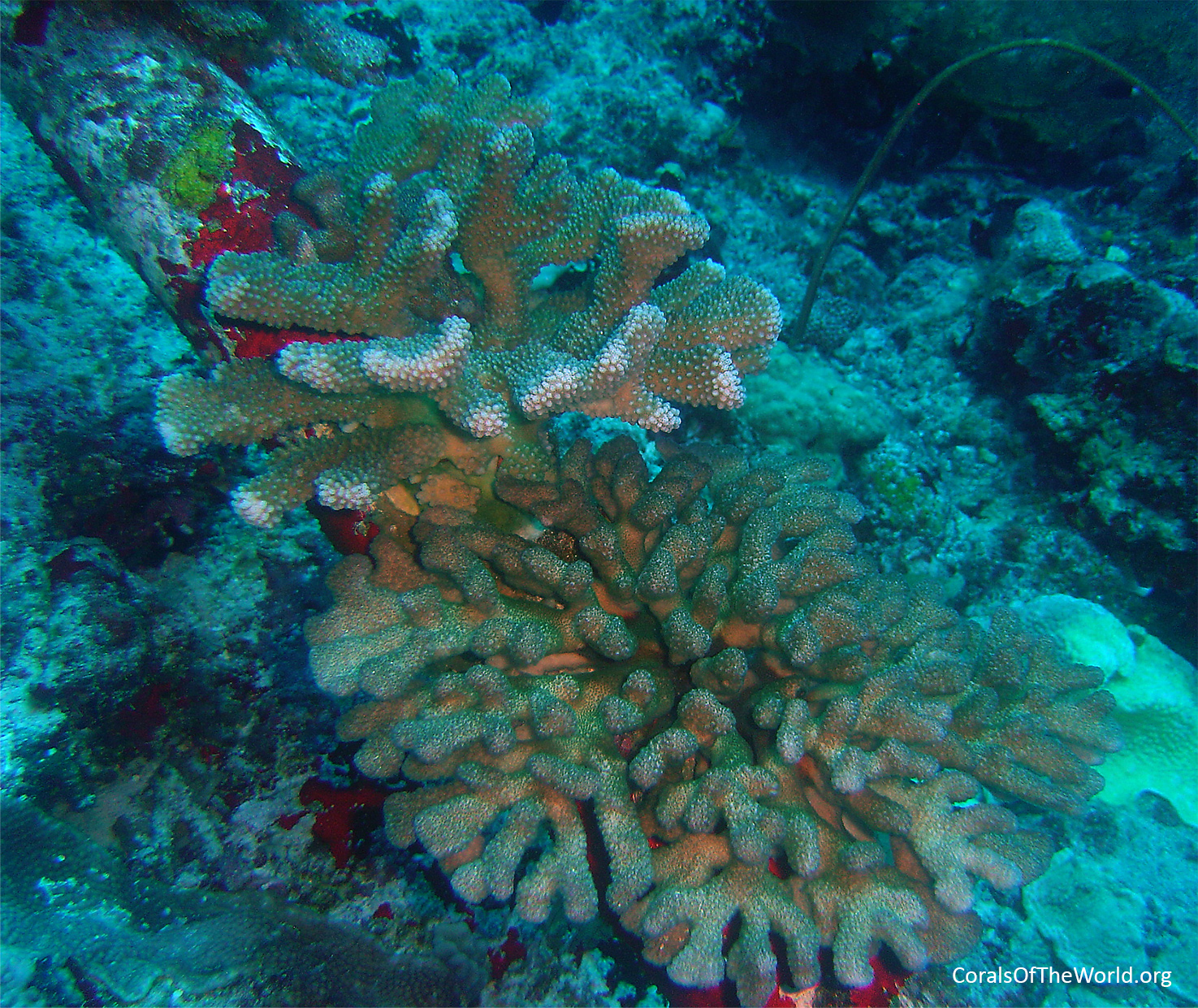
Pocillopora eydouxi (above) and P. verrucosa growing on a fallen pipe at 38m depth. Whether such corals produce planulae remains unknown Ulithi Atoll, Yap, Micronesia Photograph: Emre Turak Figure 45.
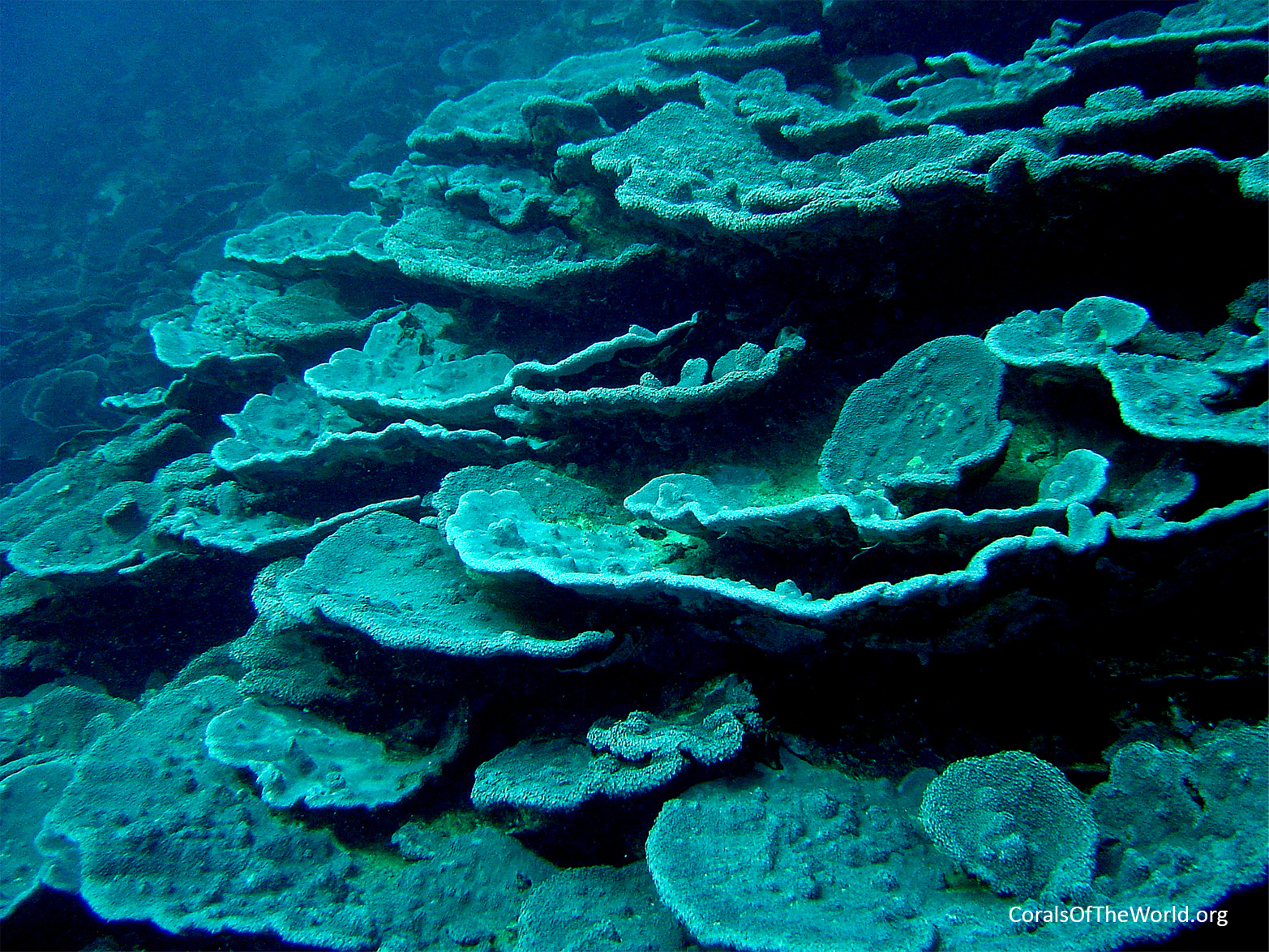
Large tiered plates of Alveopora spongiosa at 36m depth Bunaken, Indonesia Photograph: Emre Turak and Lyndon DeVantier Figure 46.
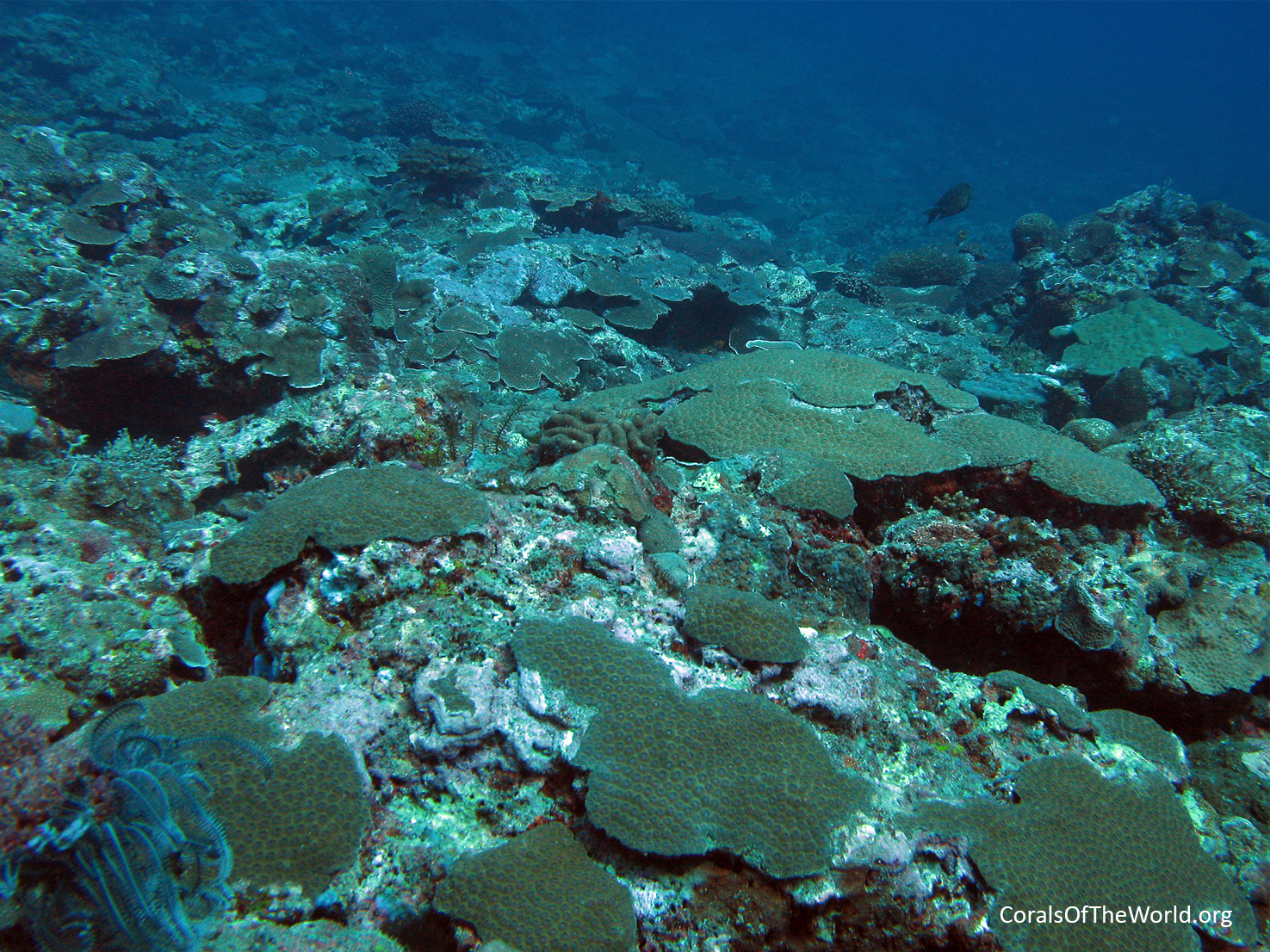
Extensive encrusting to plating cover of Diploastrea heliopora 29m depth Brunei Darussalam Photograph: Emre Turak and Lyndon DeVantier Figure 47.
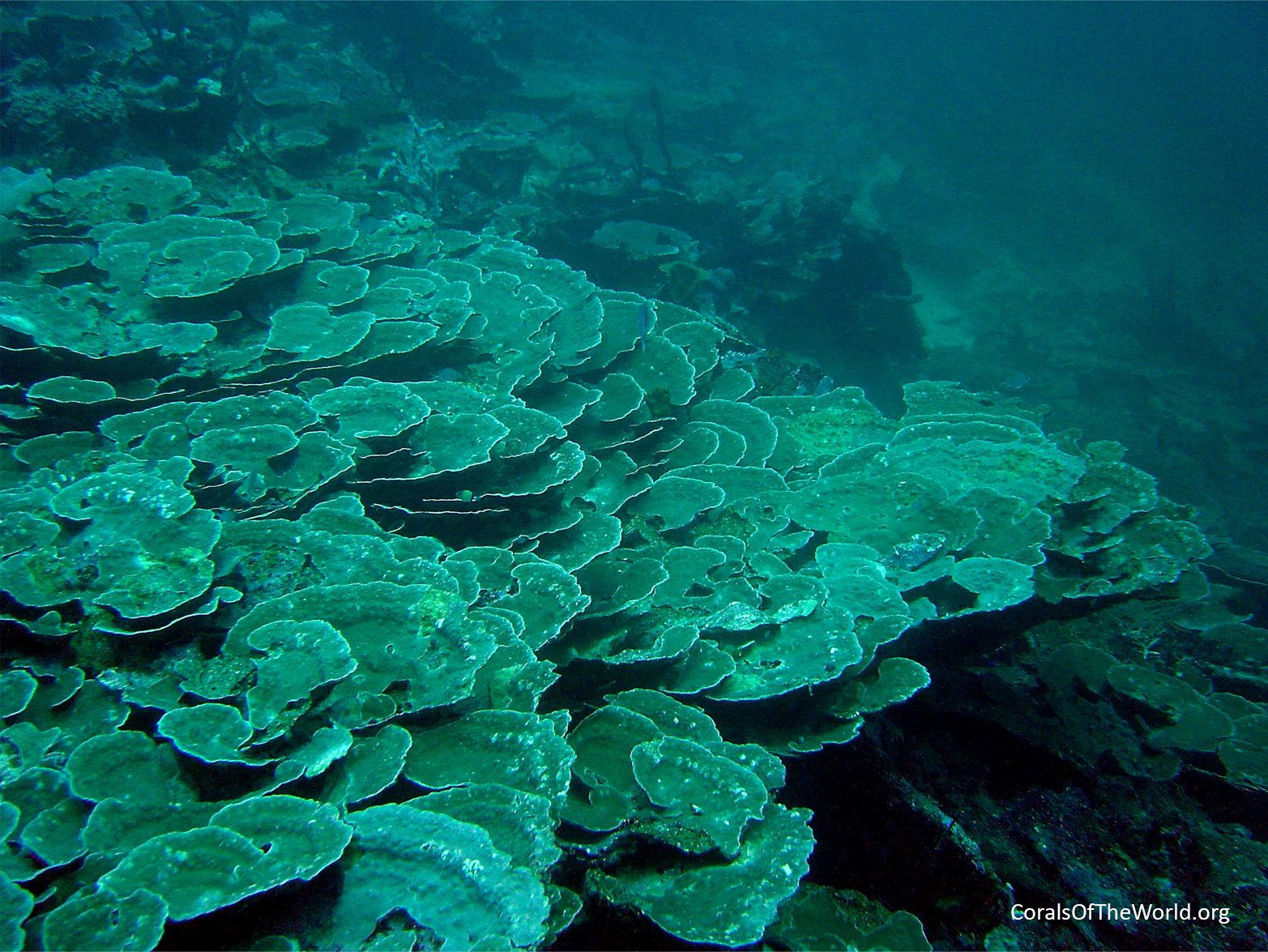
Extensive beds of a foliaceous form of Porites monticulosa 39m depth Kimbe Bay, Bismarck Sea Photograph: Emre Turak and Lyndon DeVantier Figure 48.
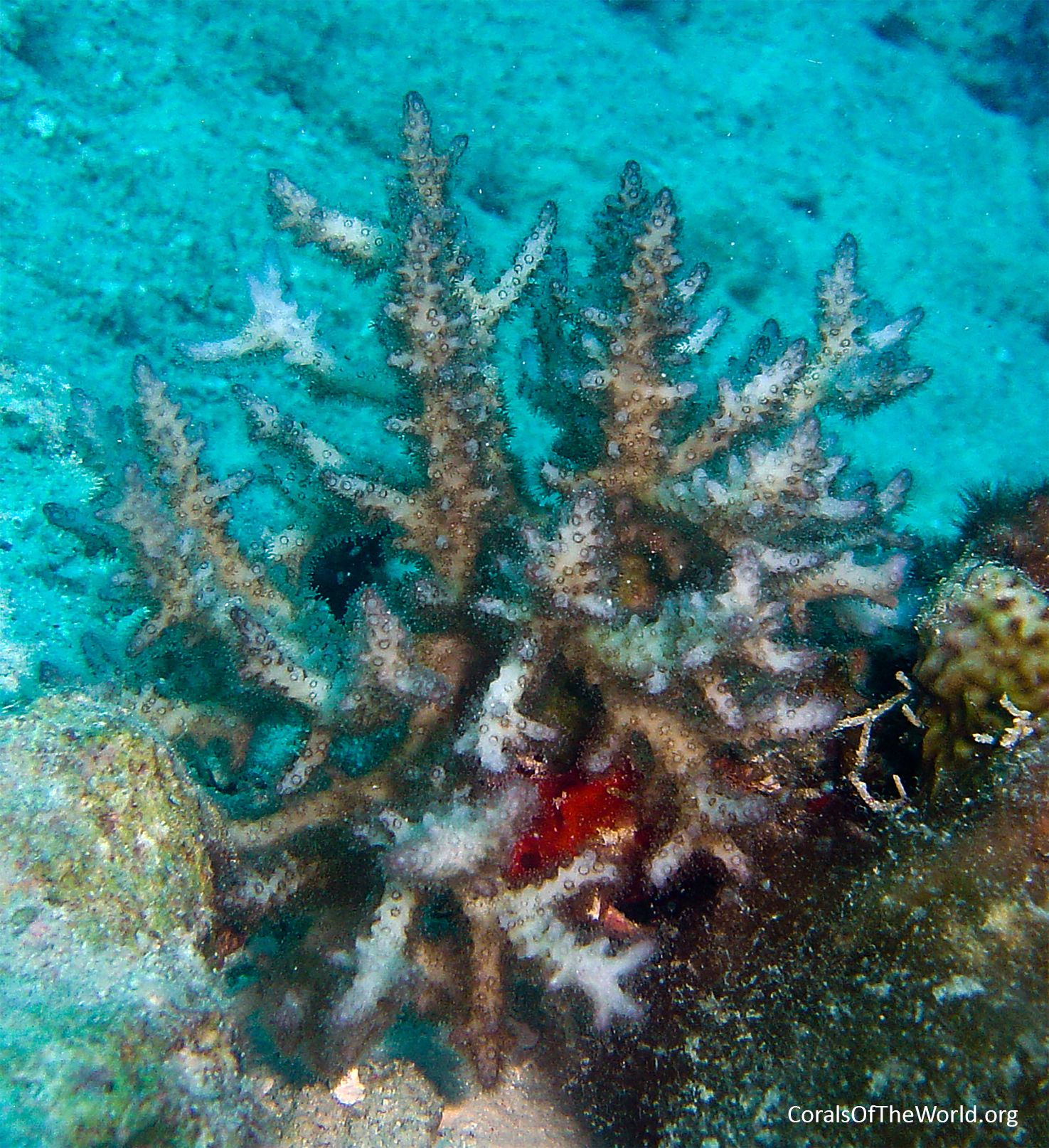
Unusual open growth form of Pocillopora damicornis 33m depth Ulithi Atoll, Yap, Micronesia Photograph: Emre Turak and Lyndon DeVantier Figure 49.
Morphology, fragmentation and local dispersal
Where light becomes limiting on corals a number of adaptations may take place. For example, on the shaded sides and bases of large massive colonies of Porites, ledges or ‘skirts’ form. Aided by bioerosion, these can ultimately become dislodged from the parent, resulting in the partial fragmentation of lower parts of colonies (DeVantier and Endean, 1989). The clone-mates or ramets so formed can be transported downslope, away from the parent, by storm waves, contributing to the broad depth range of these species. Other massive corals also adopt this strategy, albeit much less commonly than massive Porites. These include Diploastrea heliopora and Platygyra daedalea.
Branching, foliose and plating species also episodically fragment, typically during storms, and this is an important, if uncertain, mode of localized dispersal to the MZ. Those corals that survive the wild downslope ride and subsequently survive, coping with the reduced illumination, typically adopt a more open or flattened growth-form than their well-illuminated con-specifics upslope. This morphological ‘plasticity’ is one reason why corals in the same species can appear very different, having modified their phenotype to the local environment. This capacity is not constant across species, with some, notably those in the genus Acropora, being more adept than others.

Future directions
In recent decades, research on MZ corals has become widespread geographically, from initial centres in the Caribbean Sea, Hawaii and Red Sea. These have recently been joined by research groups from Japan, Micronesia, Australia, the USA and elsewhere, such that there is now a global focus on corals of the MZ. Research has also expanded to include studies of the biology, including reproduction, zooxanthellae types, feeding modes and efficiency, ecology and biogeography, along with the use of molecular genetics in unravelling complex taxonomic questions. Reasons for this increasing focus are numerous, and include the realization that shallow coral ecosystems are being increasingly impacted by disturbance, particularly mass bleaching events that have decimated reefs globally since the 1990s (see Algal symbiosis and mass bleaching). The importance of MZ corals as sources for replenishment of shallow water coral communities remains contentious, however. The fact that more than 300 Indo-Pacific coral species inhabit the UMZ provides hope that those subpopulations may act as seed-sources for recovery, although this is far from assured. Among the many questions that remain unanswered are the sizes and significance of those UMZ populations for individual species, their capacity for successful reproduction, and the resilience of UMZ corals to increasing frequencies and intensities of disturbances that spread into deeper waters.
These questions are not just of academic interest, of course, but are some of the many crucial research topics relating to the continued health of coral reefs globally. It seems almost beyond belief that the actions of humans over little more than one century, through our profligate use of fossil fuels, could endanger an entire ecosystem, although sadly that is the reality.


